Knowing what equipment can help you achieve results faster is key to your success if you want to lose weight, tone up, or build serious muscle.
Knowing where to start can be challenging, with dozens of machines, weights, bars, and other equipment lining every corner.
But it’s important to know the most common gym machines and their muscle-building benefits to maximize your workout.
This list includes over 100 popular gym equipment and machines for strength training, free weights, and cardio.
Here, you’ll learn gym equipment names, see pictures of the equipment, and understand what muscle groups each targets.
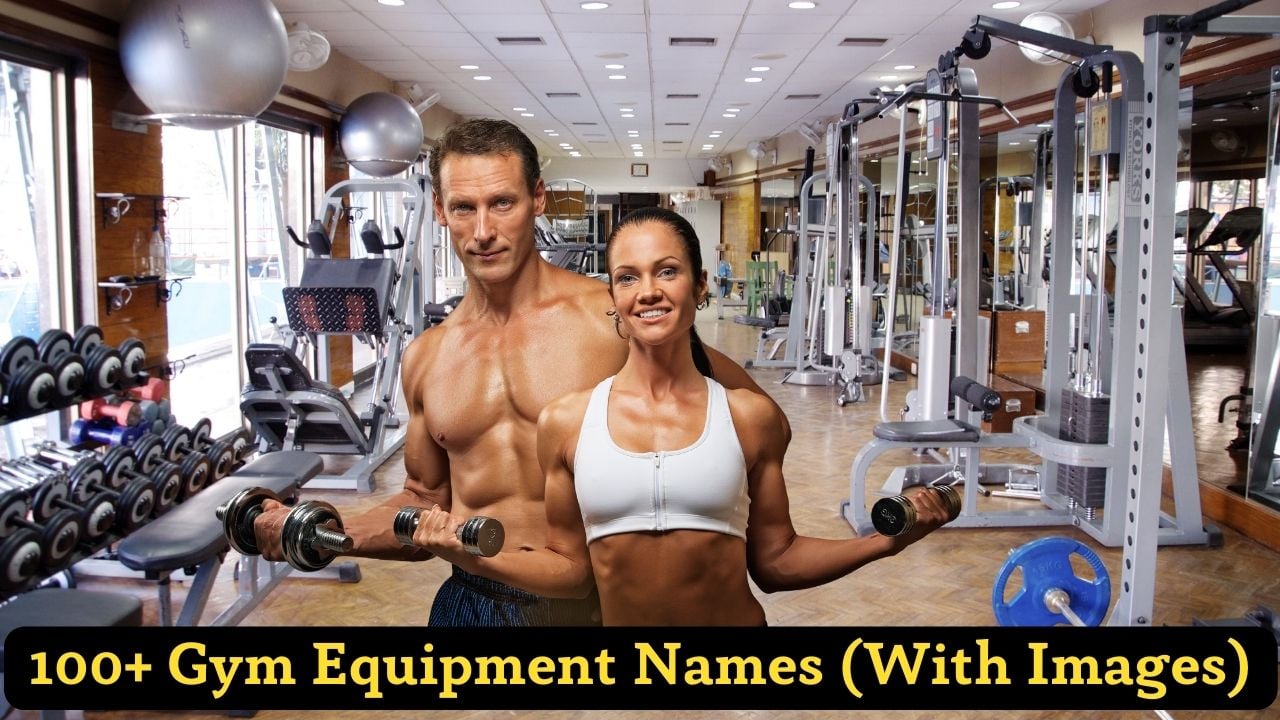
- Common Equipment For Strength Training
- 1. Dumbbells
- 2. Barbells
- 3. Weight Plates
- 4. Kettlebells
- 5. Bench
- 6. Cable Machine
- 7. Smith Machine
- 8. Squat Rack
- 9. Trap Bar (Hex Bar)
- 10. Safety Squat Bar
- 11. Bench Press
- 12. Dip Station
- 13. Pull-Up Bar
- 14. Sleds Gym Equipment
- 15. Tyre
- 16. Sledge Hammer
- Gym Accessories List
- 1. Resistance Band
- 2. TRX Suspension Trainer
- 3. Battle Ropes
- 4. Punching Bag
- 5. Weighted Vest
- 6. Climbing Rope
- 7. Ankle Weights
- 8. Sandbags
- 9. Plyo Box
- 10. Steppers
- 11. Plyo Hurdle
- 12. Weightlifting Belt
- 13. Weightlifting Chalk
- 14. Jump Rope
- 15. Gymnastic Rings
- 16. Push Up Bars
- 17. Foam Roller
- 18. Agility Ladder
- 19. Stability Ball
- 20. Bosu Ball
- 21. Medicine Balls
- 22. Hand Gripper
- 23. Barbell Collars
- 24. Yoga Mat
- Specialized Gym Machine Names
- 1. Seated Chest Press Machine
- 2. Pec Deck Machine
- 3. Cable Crossover Machine
- 4. Chest Dip Machine
- 5. ISO Incline Press
- 6. Lat Pulldown Machine
- 7. Seated Row Machine
- 8. Chest Supported Row
- 9. Landmine Row Attachment
- 10. Back Extension Machine
- 11. Shoulder Press Machine
- 12. Lateral Raise Machine
- 13. Shrug Machine
- 14. Preacher Curl Machine
- 15. Machine Tricep Dip
- 16. Forearm Wrist Curl Machine
- 17. Reverse Hyperextension
- 18. Glute Ham Raise
- 19. Seated Back Extension
- 20. Captain’s Chair
- 21. Oblique Machine Twist
- 22. Abs Crunch Machine
- 23. Abs Wheel Roller
- 24. Leg Press Machine
- 25. Leg Extension Machine
- 26. Leg Curl Machine
- 27. Hack Squat
- 28. Standing Leg Curl Machine
- 29. Standing Machine Calf Raise
- 30. Seated Machine Calf Raise
- Cardio Equipment Names
- 1. Treadmill
- 2. Elliptical Trainer
- 3. Stationary Bike
- 4. Rowing Machine
- 5. Stair Climber
- Conclusion
Common Equipment For Strength Training
When it comes to building muscle and gaining strength, not all gym equipment is created equal.
Free weights are a staple of any effective strength-training program due to their versatility, effectiveness, and proven results.
Learn about the most common tools for building a stronger and more muscular body, like dumbbells and barbells.
When you have the right tools under your belt, you will be able to lift towards your fitness goals in no time.
1. Dumbbells
Dumbbells are free weights consisting of two identical bells connected by a short, straight bar.
They’re a staple in gyms and home workout spaces because of their versatility and effectiveness in building strength, improving coordination, and sculpting muscle.
Types of Dumbbells
- Fixed-weight dumbbells: These are traditional dumbbells with a fixed weight that cannot be adjusted.
- Adjustable dumbbells: Consist of a handle and removable weight plates that can be added or removed to change the overall weight.
- Hexagonal dumbbells: Have a hexagonal-shaped weight head. It prevents them from rolling away when placed on the ground.
- Neoprene or rubber-coated dumbbells: Have a layer of neoprene or rubber around the weight head. It provides a comfortable grip and protects floors from damage.
- Adjustable selectorized dumbbells: These high-tech dumbbells have a dial or selector mechanism. That allows users to quickly adjust the weight in small increments without manually adding or removing plates.
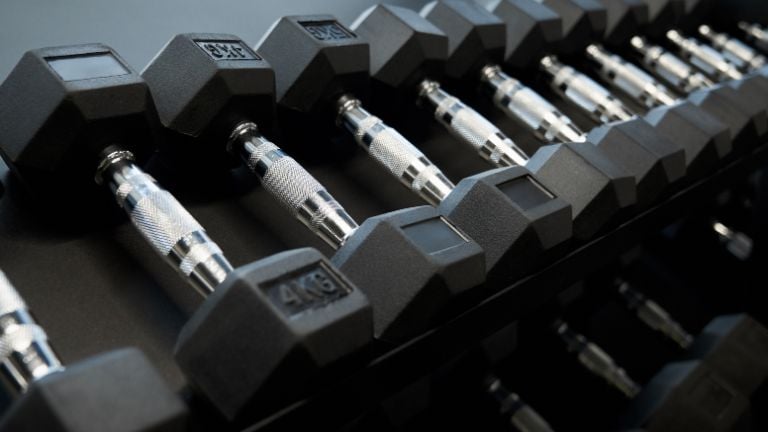
Benefits
- They offer a wider range of motion than many machines, which allows for more natural and effective movement patterns.
- Dumbbells offer various exercise possibilities, including chest presses, curls, rows, squats, lunges, and more. They can be used for both upper and lower-body workouts.
- They can be integrated into strength, bodybuilding, circuit, and cardiovascular exercises.
2. Barbells
The barbell, a long, straight metal bar with weights loaded on either end, reigns supreme as the king of strength training equipment.
It is a fundamental piece of strength training equipment and is used for various exercises to build muscle and increase strength.
Types of Barbells
- Standard Barbells: Typically weigh 45 pounds (20.4 kilograms) and have a fixed length of 7 feet (2.13 meters). They are commonly used in powerlifting and Olympic weightlifting competitions.
- Olympic Barbells: Similar to standard barbells, they are designed to be taken with a 300-680kg weight and have thicker and rotating sleeves.
- EZ Curl Bar: This type of barbell has a curved or zigzag shape in the middle. It allows for a more comfortable grip during exercises like bicep curls. It is often used for isolation exercises that target the arms.
- Swiss Bar: The bar is a rectangle with at least three or four grips spaced evenly within the bar. This construction means you can find powerlifting bars with custom barbell collar sizes.
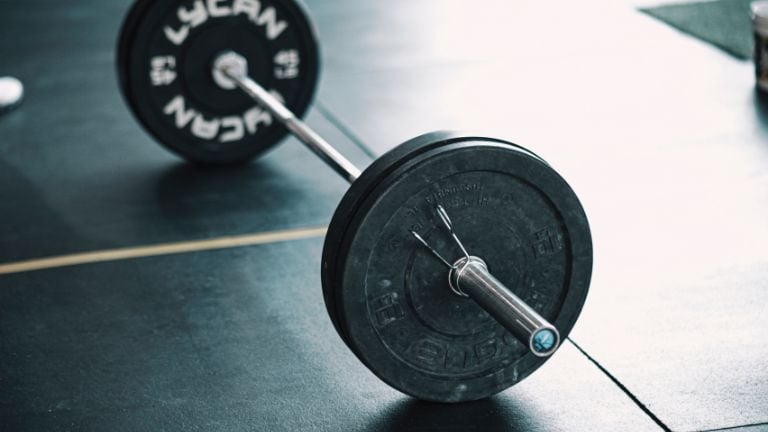
Benefits
- Barbells allow for easy weight progression by adding weight plates.
- Barbells are excellent for compound exercises like squats, deadlifts, bench presses, and overhead presses.
- Barbell workout works multiple muscle groups simultaneously.
3. Weight Plates
Weight plates, the unsung heroes of the gym, are flat, circular discs made of cast iron or other materials designed to add resistance to barbells and weight machines.
These simple disks hold immense power, shaping muscles and building strength.
Types of Weight Plates
- Standard Weight Plates: These plates have a 1-inch diameter hole and are designed for standard barbells with a 1-inch sleeve.
- Olympic Weight Plates: Olympic weight plates have a 2-inch diameter hole and are designed to fit Olympic barbells. They come in various weights and are often color-coded for easy identification.
- Bumper plates: Made of rubber or urethane for added durability and reduced noise when dropped. They were often used for Olympic weightlifting exercises.
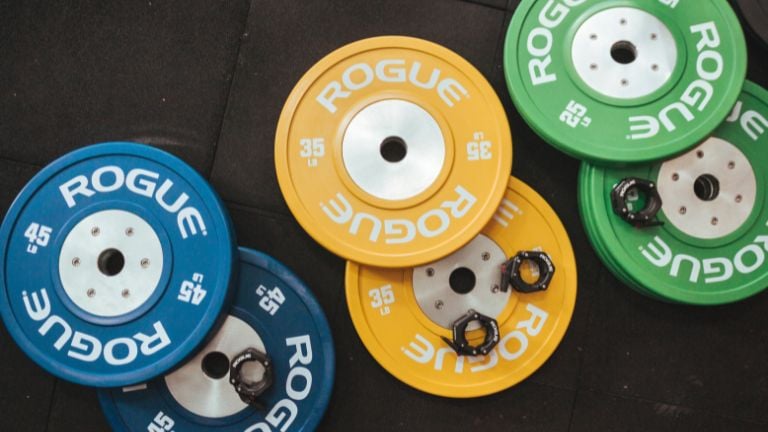
Benefits
- You can adjust the resistance with weight plates’ various sizes and weights.
- Good plates can withstand heavy use and drops for a long time, so they are worth investing in.
4. Kettlebells
A kettlebell is a weight made of cast iron or steel with a handle resembling a cannonball.
It is used in various strength and conditioning exercises, offering a unique and versatile tool for full-body workouts.
Types of Kettlebells
- Traditional Kettlebells: These are the classic kettlebells with a single cast iron or steel construction. They are available in various weights, ranging from a few pounds to over 100 pounds.
- Adjustable Kettlebells: Some kettlebells come with a removable weight plate system. It allows you to adjust the weight by adding or removing plates as needed.
- Competition kettlebells: Made from smooth, high-quality steel with precise weight markings. It is designed for official kettlebell sports competitions.
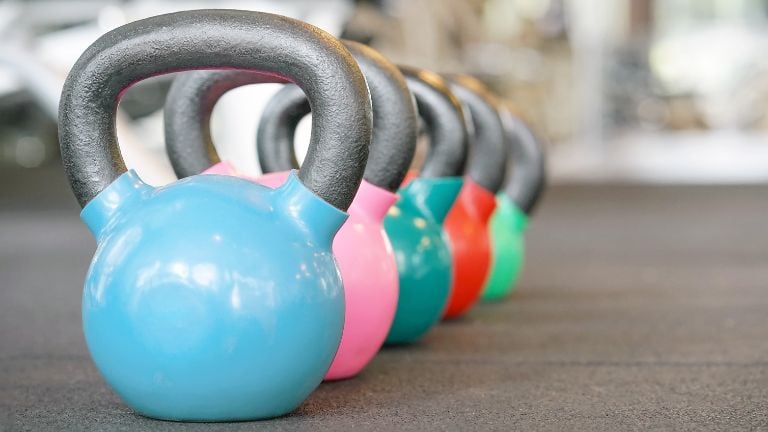
Benefits
- Kettlebell workouts combine cardio and strength training. They make your heart beat faster and help you build muscle simultaneously.
- They are relatively compact and easy to store, making them suitable for home workouts and travel.
- They can be used for various exercises like swings, snatches, cleans, presses, and Turkish stand-ups.
5. Bench
A workout bench is also known as an exercise bench or weight bench. It is a piece of fitness equipment designed to provide a stable surface for various strength training exercises.
It typically consists of a padded seat and backrest, with a sturdy frame that can be inclined, declined, or kept flat.
Types of Workout Benches:
- Flat Bench: The most basic type, with a fixed, horizontal platform ideal for exercises like bench presses, dumbbell rows, and skull crushers.
- Adjustable Bench: An adjustable bench can be set at different angles, including incline and decline positions. It expands your exercise options to target different muscle groups in your chest, back, shoulders, and core.
- Decline Bench: Specifically designed with a downward slope to focus on your lower chest and decline sit up.
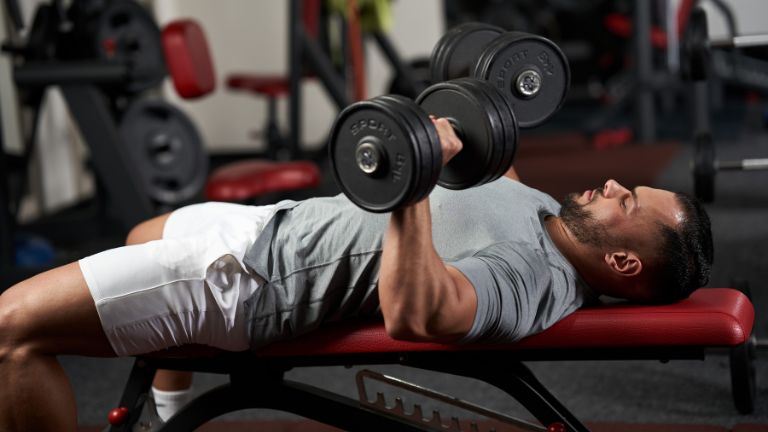
Benefits
- Workout benches provide a stable and secure platform for performing various strength training exercises.
- The different bench types and adjustable options enable a wide range of exercises.
- The padded seat and backrest of workout benches offer comfort during exercises.
6. Cable Machine
A cable machine is usually found in gyms and fitness centers. This exercise is used for weight training or functional training to target all major muscle groups.
It consists of a steel frame that houses a series of pulleys, cables, and weight stacks.
The cables are attached to different types of handles or attachments, which you can pull or push to do many different exercises.
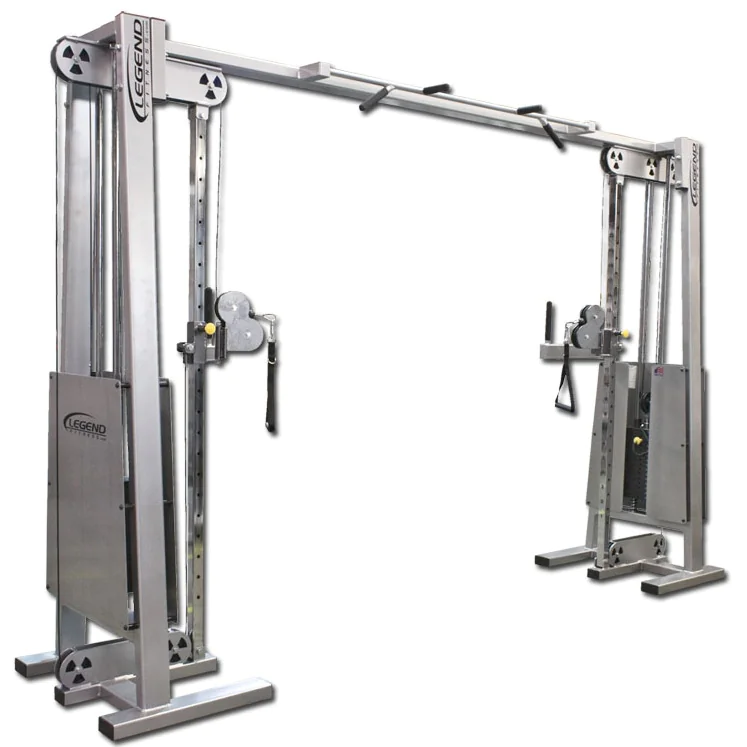
Benefits
- They allow for various exercises that target multiple muscle groups, from the upper body and core to the lower body.
- Generally safer for solo workouts, with less risk of dropping weights or losing control of the equipment.
- Suitable for all fitness levels, from beginners to advanced. Thanks to adjustable weight stacks and pulley heights.
- The pulley and cable system provides a smoother, more controlled range of motion compared to some free weights.
- Various handle attachments allow tailored workouts targeting specific muscles or movement patterns.
Exercises
Featuring two adjustable pulleys, this machine allows you to perform various pulling and lifting movements from various angles, optimizing your back training for strength, hypertrophy, or endurance.
Here are some effective back exercises you can perform on this versatile machine:
- Cable Lateral Raise: It offers an effective way to train the lateral Deltoid.
- Cable Front Raise: It is a particular focus on the anterior deltoid.
- Face Pulls: Great for working the rear deltoids and upper traps, also beneficial for shoulder health.
- Straight-Arm Pulldown: Isolates the lats without involving the biceps. It is a great finishing move for a back workout.
- Single-Arm Cable Row: Allows for a greater range of motion and isolates one side of your back at a time.
- Cable Pull-Through: Primarily targets the lower back and glutes but also engages the lats during pulling.
- Cable High Row: Targets upper lats and traps, great for sculpting the upper back.
- Cable Y-Raise: Focuses on the lower traps and helps improve posture and shoulder stability.
- Cable Shrugs: Targets the upper trapezius, great for building bigger shoulders.
- Cable Upright Row: Mimics the motion of a T-bar row, emphasizing the middle and upper back.
- Standing Low Cable Row: This variant targets the lats and lower traps while engaging the core for stabilization.
7. Smith Machine
The Smith Machine is a versatile piece of gym equipment that consists of a barbell fixed within steel rails, allowing for vertical or near-vertical movement. This setup provides an element of safety and control that’s not always present in free-weight exercises.
The Smith Machine’s adjustable safety stops make it a great choice for various workouts, from deadlifts and Smith Machine upright rows to chest presses and squats.
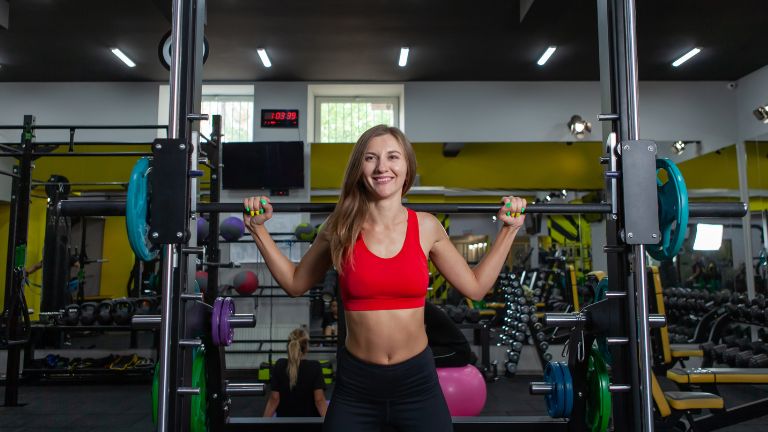
Benefits
It’s a one-stop shop for both newbies and seasoned athletes. Let’s explore using this machine for a robust and varied back workout.
The muscles targeted on the Smith Machine can vary based on the exercises chosen. However, here are some of the most commonly targeted muscles:
- Smith Machine Overhead Press: It primarily targets the shoulder muscles and helps to build strength and mass.
- Smith Machine Upright Row: Pulling the barbell towards your chin will engage the deltoids and upper and Middle trapezius.
- Smith Machine Behind Neck Press: This emphasizes the side and rear delts more. Carefully press the bar up from behind your head, being cautious not to strain your neck.
- Rack Pulls: Focus on the lower traps, latissimus dorsi, and erector spinae.
- Smith Machine Shrugs: This exercise primarily targets the upper trapezius and rear deltoid muscles. It’s a simpler movement but effective for adding strength and size to the upper shoulders and neck region.
- Bent-Over Rows: Target the latissimus dorsi, rhomboids, and middle trapezius.
- Smith Machine Rear Delt Row: It targets the rear deltoids and helps to improve posture and upper back strength.
8. Squat Rack
A squat rack is a piece of strength training equipment specifically designed for performing squats.
It provides a safe and efficient way to perform heavy squats and other weightlifting exercises.
Types of Squat Racks
- Power Rack (Full Cage): Four vertical posts with adjustable horizontal safety bars. It is ideal for those who lift heavy weights and require maximum safety.
- Half Rack: Similar to a full cage but with an open design, usually having two vertical posts. It is good for intermediate lifters.
- Squat Stand: Two separate stands with a vertical post and base—a space-saving solution for squats and light presses.
- Fold Away Squat Rack: This can be folded and stored against a wall.
- Combo Rack: A combination of a squat rack and a bench press rack.
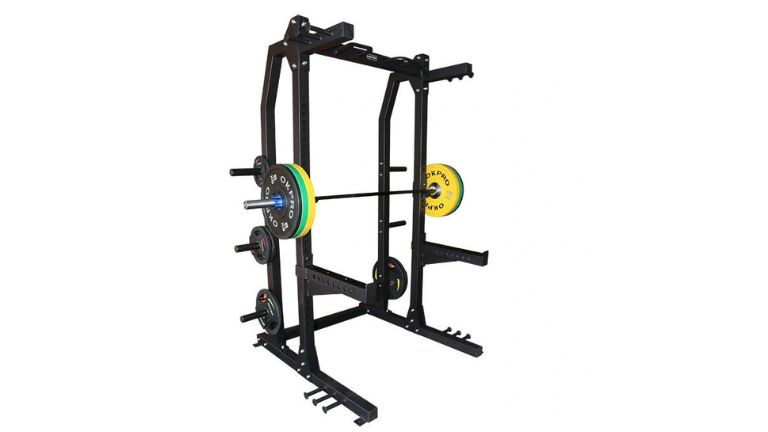
Benefits
- The safety catches and adjustable supports provide a secure environment for heavy squats and pressing exercises.
- It can be used for various exercises beyond squats, including bench presses, overhead presses, and deadlifts.
9. Trap Bar (Hex Bar)
The Trap Bar, also known as a Hex Bar, is a specialized type of weightlifting bar designed to alleviate stress on the lower back and engage different muscle groups during exercises like deadlifts and squats.
Its unique hexagonal shape allows the user to stand inside it, offering a more neutral grip and body positioning.
Unlike a traditional barbell, the weight plates load inside the frame, distributing weight evenly around the user.
Types of Trap Bars
- Standard Trap Bar: Hexagonal shape with two parallel handles on each side.
- Open-Back Trap Bar: A hex bar with an open back, allowing for a greater range of motion.
- Dual-Handle Trap Bar: Two sets of handles, one set higher than the other.
- Rackable Trap Bar: Designed to fit on standard-weight racks.
- Rotating Handle Trap Bar: Handles that can rotate, reducing strain on the wrists and forearms.
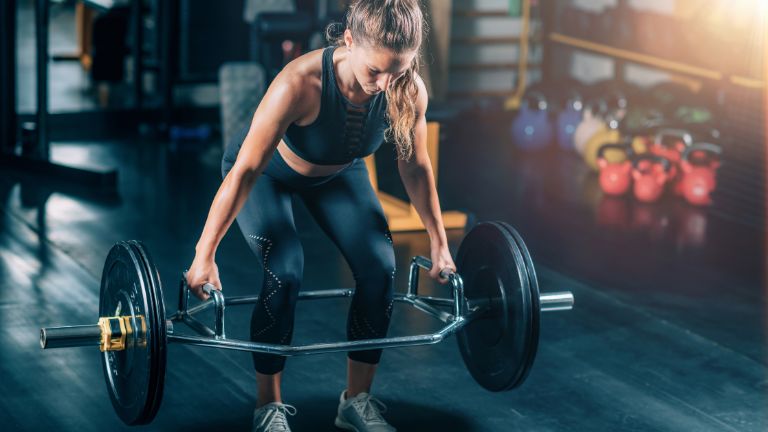
Benefits
- The neutral grip and evenly distributed weight minimize stress on the lower back compared to a traditional barbell deadlift.
- The handles activate your forearms and grip muscles more effectively.
10. Safety Squat Bar
A Safety Squat Bar (SSB) is a specialized type of barbell designed for squatting.
Its ergonomic design makes it a suitable alternative for lifters with limitations with traditional squats due to shoulder, wrist, or elbow issues.
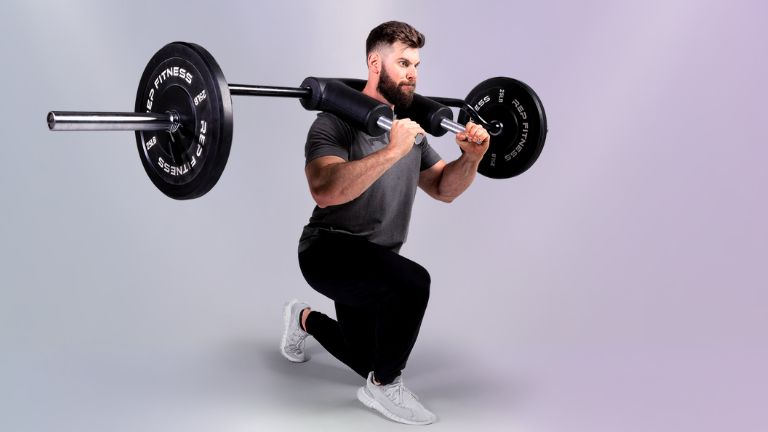
Benefits
- The handles and design offer increased control during the lift.
- The comfortable grip and reduced stress on the lower back during squat.
11. Bench Press
A key piece of equipment in gyms is the bench press, which is primarily used for upper-body strength training.
The bench press setup typically consists of a flat bench and a rack designed to hold a barbell.
Type of Bench Press
- Flat Bench Press: A flat bench with a rack. The most standard and common type. It is best for targeting the middle part of the chest muscles.
- Incline Bench Press: The bench is set at an incline (usually between 15 and 45 degrees). It focuses more on the upper chest and shoulders.
- Decline Bench Press: The bench is set at a decline. It works well on the lower part of your chest muscles.

Benefits
- Primarily strengthens the chest, shoulders, and triceps.
- Different types of bench presses allow for a comprehensive chest workout.
- A key component of strength training and bodybuilding routines.
12. Dip Station
A Dip Station, also called a parallel bar or a dip bar, is a tool for doing dips, which work on the upper body muscles.
Dip stations are simple yet effective tools for strength training.
Types of Dip Stations
- Standard Dip Stations: Two parallel bars fixed at an appropriate height.
- Wall-Mounted Dip Stations: Space-saving option that bolts directly to a wall. It is ideal for home gyms or garages.
- Adjustable Dip Stations: The height and width of the bars can be adjusted.
- Portable Dip Bars: Lightweight and can be disassembled for easy transport and storage.
- Multi-Function Dip Stations: Often combined with other equipment like pull-up bars or push-up stands.
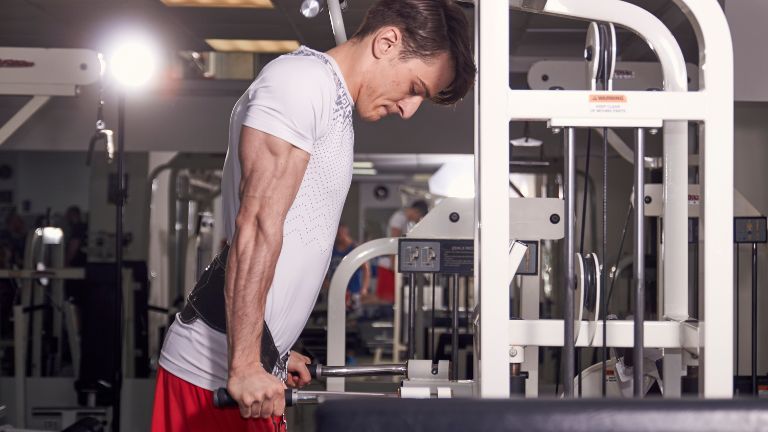
Benefits
- Excellent for building strength in the triceps, chest, and shoulders.
- Suitable for all fitness levels, from beginners to advanced athletes.
13. Pull-Up Bar
The pull-up bar is a simple horizontal bar that can help you build upper body strength.
It’s a must for doing pull-ups, but it can also be used for chin-ups, leg raises, dead hangs, and more.
Types of Pull-Up Bars
- Doorway Pull-Up Bars: Space-saving and affordable. They easily fit over most doorways. It is suitable for home workouts.
- Wall-Mounted Pull-Up Bars: Sturdy and permanent. They’re bolted directly to the wall.
- Freestanding Pull-Up Towers: Portable and multi-functional.
- Multi-Grip Pull-Up Bars: Feature different grip positions (wide, narrow, neutral).
- Ceiling-Mounted Pull-Up Bars: Mounted to the ceiling. Provide a higher bar position.
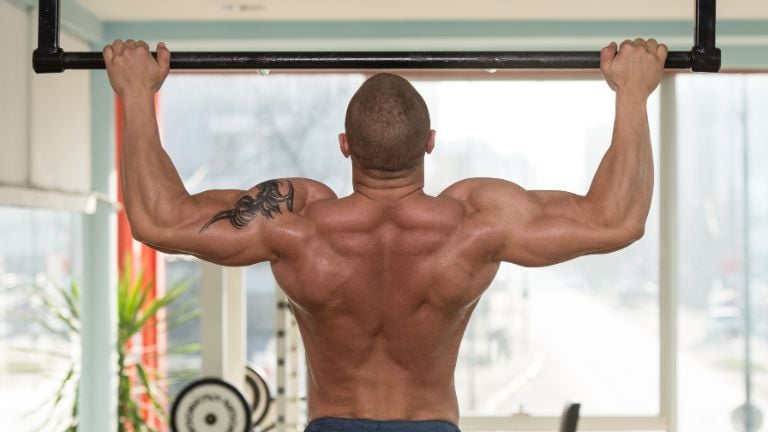
Benefits
- Generally a budget-friendly option compared to other fitness equipment.
- Many types, especially doorway bars, take up little space and are great for small home gyms.
14. Sleds Gym Equipment
It is designed for both pushing and pulling exercises. It usually has vertical and horizontal handles.
Sleds are primarily designed for dragging exercises. It often comes with straps or a harness.
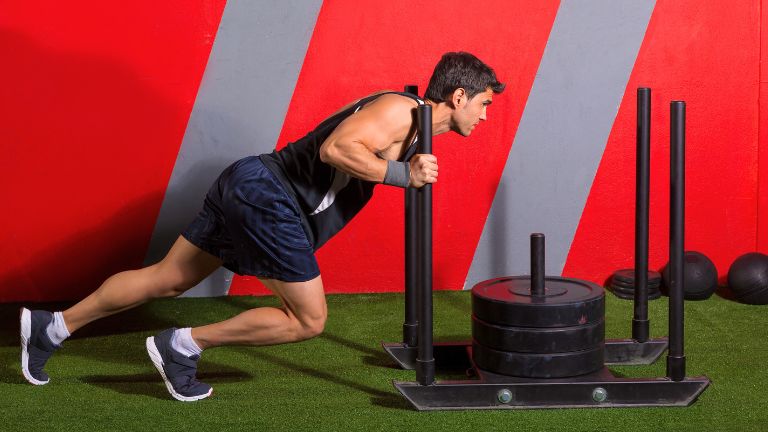
Benefits
- It can be used for various exercises, such as pushing, pulling, dragging, and sprinting.
- It is best for athletes who need to develop explosive speed and power.
15. Tyre
A Tire for gym workouts is often called a fitness or training tire. It is a large, heavy rubber tire typically used in functional training, strength training, and conditioning workouts.
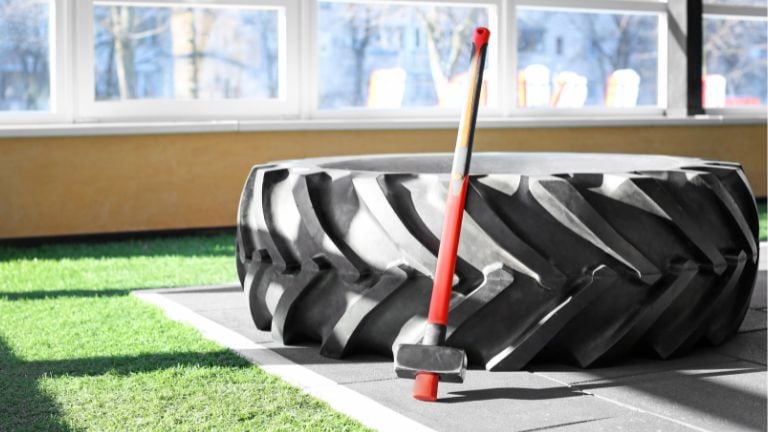
Benefits
- Tire Flipping: Lifting and flipping the tire end over end.
- Sledgehammer Slams: Striking the tire with a sledgehammer.
- Jumping Exercises: Jumping in and out of the tire or onto it.
- Step-Ups: Using the tire as a platform for step-up exercises.
- Tire Drags: Attaching a rope or harness to the tire and dragging.
- Pushing Exercises: Pushing the tire across a distance, similar to a prowler sled workout.
16. Sledge Hammer
A Sledge Hammer is typically used in Functional Training style workouts, with the athlete repeatedly smashing down the hammer into a tyre as hard as possible.
It is a great way to improve the ability to maintain explosive power. Constructed from a single piece of steel, this ensures maximum durability.
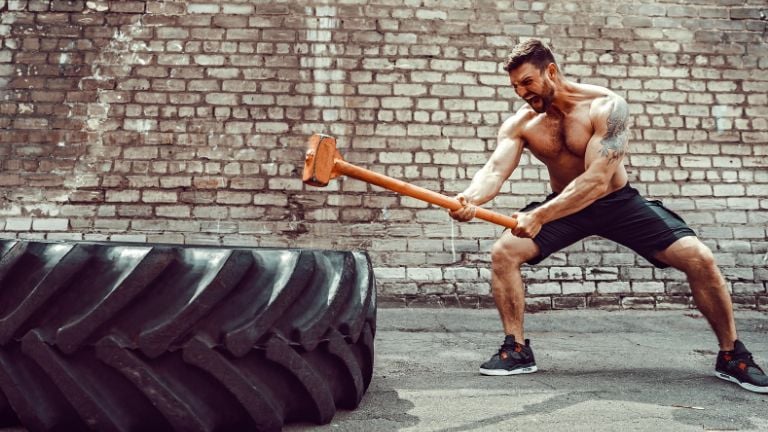
Benefits
- Sledgehammer swings can be a good cardiovascular workout.
- The rotational and slamming movements significantly engage and strengthen the core muscles.
- Handling the sledgehammer improves grip and forearm strength.
Gym Accessories List
Beyond the standard equipment like weights and machines, a host of smaller specialty gym accessories can make your training more convenient, comfortable and effective.
These accessories, from weight-lifting gloves and belts to foam rollers and exercise balls, serve more specialized purposes.
The right gym accessories can improve certain workouts, improve technique, and give extra support.
1. Resistance Band
You can use various gym equipment or your body weight to build resistance. Barbells, dumbbells, resistance bands, and weight machines are all common resistance tools used for workouts.
They are lightweight, portable, and can be used anywhere, making them convenient for workouts.
Type Of Resistance Band
- Flat Loop Bands: These are versatile, wide, flat bands that are looped in a circle. They are often used for exercises like squats or deadlifts but can be used for tricep exercises, too.
- Tube Bands with Handles: These are tubular, often come with handles on each end, and are ideal for exercises like tricep kickbacks or extensions.
- Thera bands are typically flat and thin and can be held or tied. They are suitable for rehabilitation or lighter resistance exercises.
Benefits
- In contrast to free weights, where gravity affects tension, resistance bands provide continuous tension as you stretch them.
- This means that the resistance increases the further you stretch the band. Make the exercise more challenging at the point of peak contraction.

2. TRX Suspension Trainer
It is a type of bodyweight exercise equipment that uses gravity and the user’s body weight to perform various exercises.
TRX (Total Resistance Exercise) is designed to improve strength, balance, flexibility, and core stability.
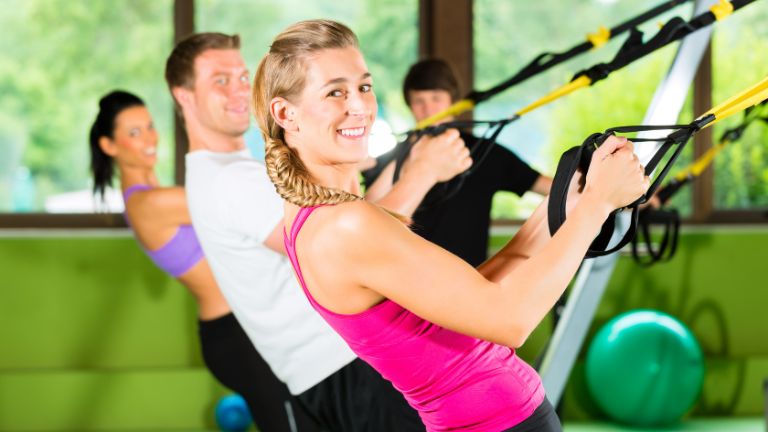
Benefits
- Train the core, upper body, lower body, and back while also working all the major muscle groups.
- The unstable nature of suspension training improves balance and flexibility.
- Compact and easy to set up. It is suitable for use almost anywhere.
3. Battle Ropes
Battle Ropes, also known as heavy ropes, are used for high-intensity interval training (HIIT), cardio, and strength training.
They are long, thick ropes that provide a dynamic, full-body workout and are often found in gyms and used in functional training programs.
Commonly, it ranges from 30 to 50 feet long and 1.5 to 2 inches in diameter.
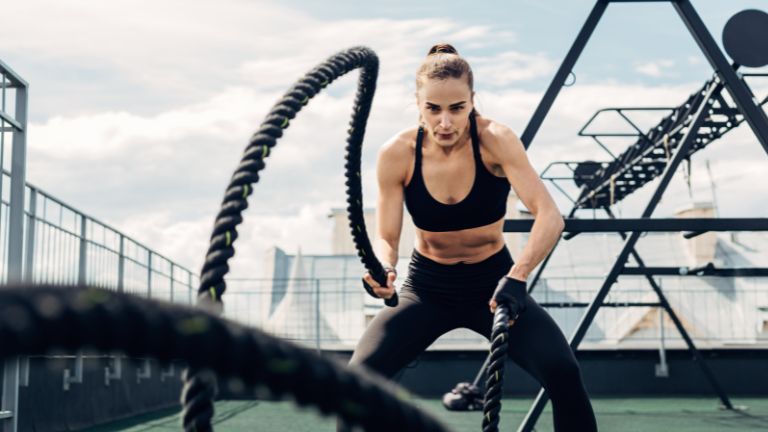
Benefits
- It is excellent for aerobic conditioning and increasing heart rate, especially in HIIT workouts.
- The rhythmic nature of rope exercises enhances coordination and rhythm.
4. Punching Bag
A Punching Bag is a durable, heavy bag used in physical training, martial arts, and combat sports for practicing punching, kicking, and other striking techniques.
It is essential for improving strength, coordination, and cardiovascular fitness.

Types of Punching Bags
- Heavy Bag: Standard, large bag, usually hanging from the ceiling.
- Speed Bag: Small, air-filled bag fixed to a rebound platform.
- Free-Standing Bag: A heavy bag mounted on a stand.
- Double-End Bag: Small, round bag connected by elastic cords on both ends
- Uppercut Bag: Designed specifically for practicing uppercuts and body shots.
- Muay Thai Bag: Long, thin bag that reaches almost to the floor, suitable for Muay Thai training, including kicks and knee strikes.
- Body Opponent Bag (BOB) or Dummy Bag: Human-shaped bag for a more realistic training experience, good for target practice.
Benefits
- Provides a high-intensity cardiovascular workout.
- Useful for practicing and improving self-defense techniques.
5. Weighted Vest
A Weighted Vest is designed to add extra weight to the body during exercises.
It is usually made from durable, breathable materials with adjustable straps for a secure, comfortable fit.
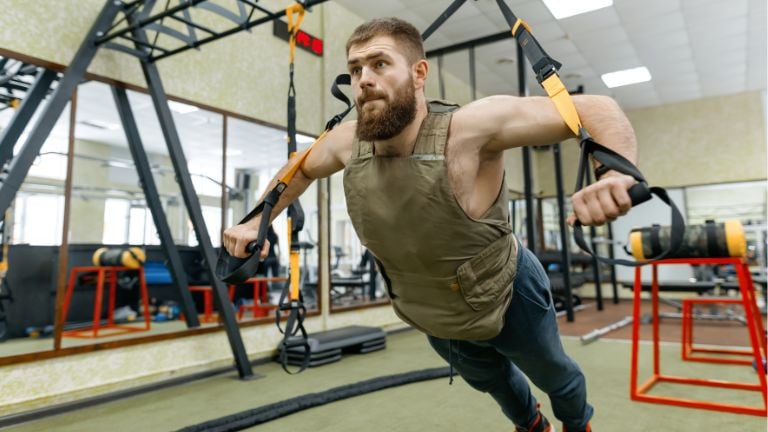
Benefits
- Adds extra resistance to bodyweight exercises.
- It can be used in various exercises, including walking, running, bodyweight exercises, and agility training.
6. Climbing Rope
Climbing rope is a specialized type of rope used in rock climbing, mountaineering, and other outdoor activities.
Climbing ropes are designed to be strong, durable, and capable of sustaining the weight of a climber.
They come in different sizes and materials, such as nylon, polyester, and aramid fibers. The diameter is typically between 1 and 2 inches and is specifically designed for easy gripping.
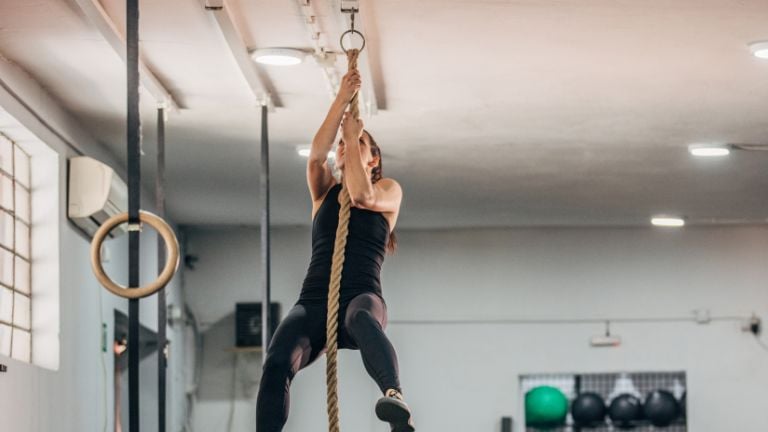
Benefits
- Excellent for building grip, arm, shoulder, and back strength.
- Challenges and develops mental focus and determination.
- Challenges and develops mental focus and determination.
7. Ankle Weights
Ankle weights, those little loops of sand-filled bliss (or leaden doom, depending on your perspective), are incredibly versatile fitness accessories.
They come in various forms, including adjustable and non-adjustable weights.
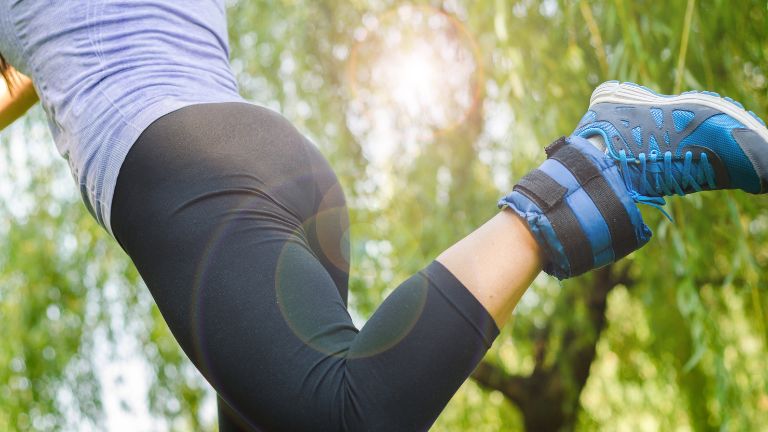
Benefits
- You can incorporate ankle weights into various activities like walking, running, dancing, yoga, Pilates, and even strength training exercises.
8. Sandbags
These sand-filled bags allow a flexible weight that shifts as you move it. It offers a unique challenge compared to traditional weights.
Some sandbags can adjust weight by adding or removing sand-filled bags.
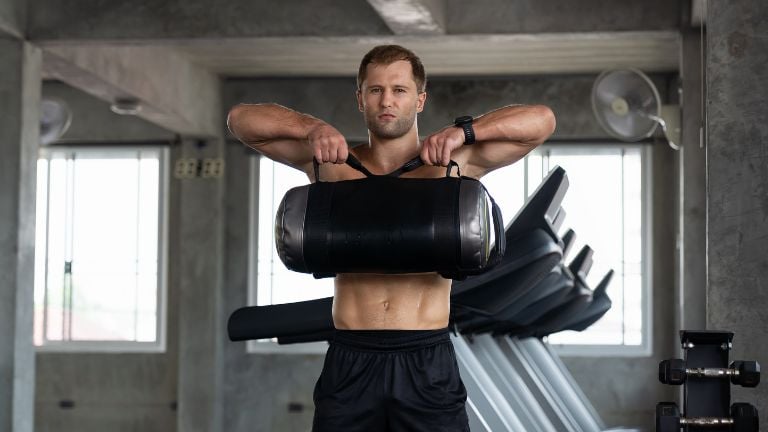
Benefits
- They are equipped with various handles and grips to facilitate various exercises and grips.
- The unstable weight of the sandbag adds a unique resistance challenge.
9. Plyo Box
The plyo box, a wooden cube, is more than just a piece of gym furniture. It’s a gateway to explosive power, improved agility, and sculpted legs.
It’s the playground of plyometrics, a type of training that utilizes jump movements to build strength, speed, and reaction time.

Benefits
- Plyo box workouts increase your heart rate and help you burn serious calories.
- Box jumps, lateral box jumps, step-ups, and box burpees are some exercise variations you can do with them.
10. Steppers
This seemingly simple piece of equipment offers a surprising amount of versatility and effectiveness.
They provide a low-impact cardiovascular workout and help strengthen the lower body muscles.
Types of Steppers:
- Basic steppers: These simple platforms with adjustable heights offer a classic stepping experience.
- Mini steppers: Compact and portable, these steppers allow for stepping while standing or seated. It is perfect for desk work breaks or apartment living.
- Twist steppers: Add a twist to your workout with platforms that rotate. It engages your core and obliques alongside your lower body.
- Stair steppers: Mimic the feel of climbing stairs.
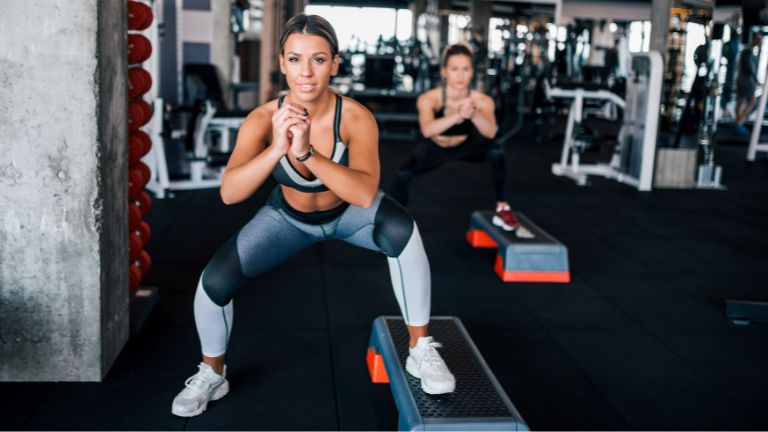
Benefits
- Simple, low-impact cardio workouts and small spaces.
- Many models, especially basic and mini steppers, have a small footprint, suitable for home use.
11. Plyo Hurdle
Plyometric Hurdles, often called Plyo Hurdles, are used for explosive training like jumping, hopping, and bounding.
They are popular in athletic training programs to enhance speed, power, and agility.
Types of Plyo Hurdles
- Adjustable Hurdles: Height can be adjusted. It allows for varied difficulty levels.
- Collapsible Hurdles: Designed to collapse or break away upon impact for safety.
- Fixed-Height Hurdles: Hurdles with a non-adjustable, set height.
- Foam Hurdles: Made from lightweight foam for safety.
- Mini Hurdles: Lower height, focusing more on speed and agility rather than high jumps.
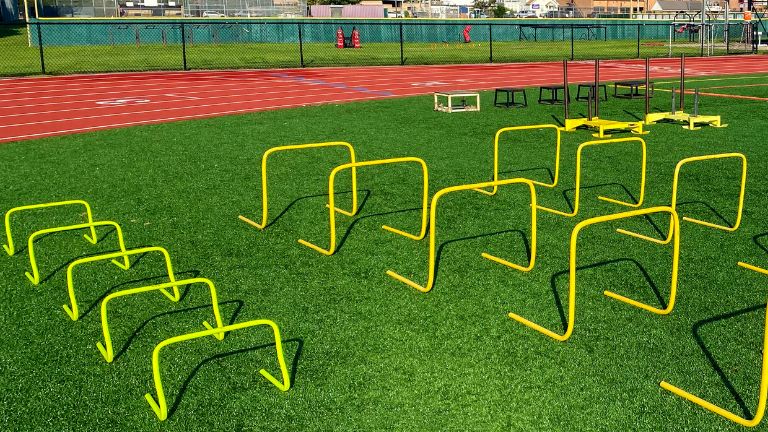
Benefits
- It is beneficial to athletes who perform sports that require jumping, sprinting, and quick directional changes.
- Hurdle workouts enhance agility, balance, and coordination.
12. Weightlifting Belt
Weightlifting belts are essential training equipment for athletes of all levels, including CrossFit athletes, Olympic lifters, powerlifters, and everyday athletes.
It is important to support the lower back and core during weightlifting exercises like squats, deadlifts, and overhead presses.
It is typically made of leather or nylon and comes in various sizes and thicknesses.
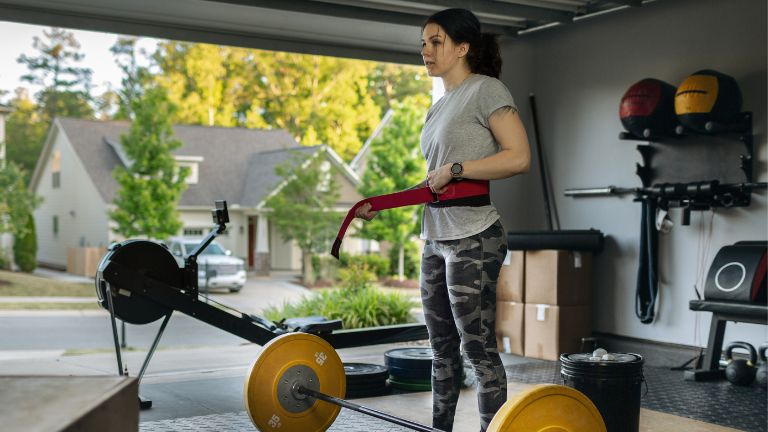
Benefits
- The added support can allow you to lift heavier weights safely.
- The belt can offer temporary relief and support during lifting for individuals with existing back pain.
13. Weightlifting Chalk
Weightlifting Chalk, gym chalk, or lifting chalk is substance athletes and weightlifters use. It improves their grip on equipment like barbells, dumbbells, and kettlebells.
It is primarily made from magnesium carbonate, effectively absorbing moisture and sweat from the hands.
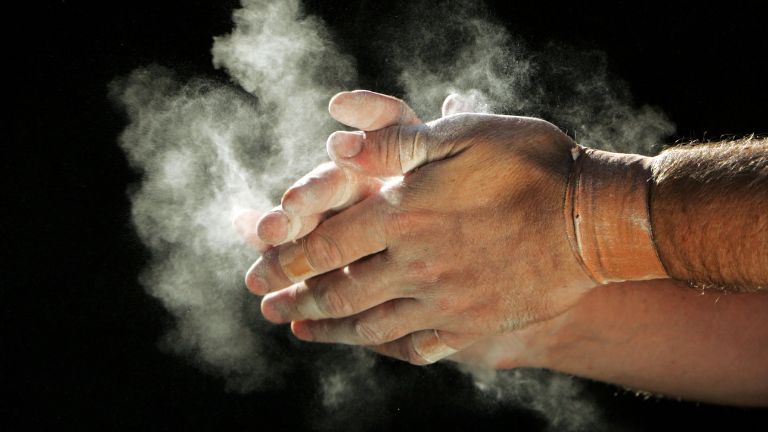
Benefits
- The primary benefit of chalk is its ability to absorb moisture from your hands. It creates a drier surface for better grip on barbells, dumbbells, and other equipment.
- Provides a protective layer on the skin.
14. Jump Rope
A Jump Rope, also known as a skipping rope. It is a simple yet highly effective cardiovascular fitness and agility training tool.
It consists of a long rope with handles on either end and is used by continuously swinging the rope over the head and under the feet.
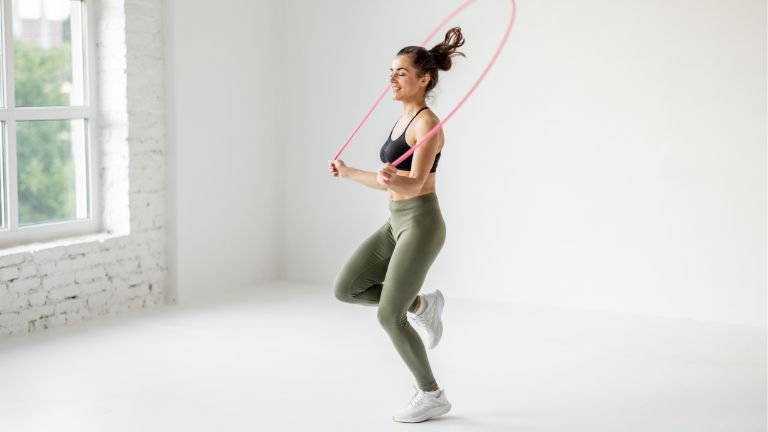
Types of Jump Ropes
- Speed Ropes: Lightweight and designed for speed. It is often made with thin wire or plastic.
- Weighted Ropes: Heavier ropes. It’s best for strength training, endurance building, and burning more calories.
- Beaded Ropes: Segmented with plastic beads.
- Leather Ropes: Made of leather, offering a more traditional feel and weight.
- Adjustable Ropes: Length can be adjusted
- Smart Ropes: Equipped with technology to track jump counts, calories burned, and workout times.
Benefits
- It is highly effective for weight loss and burning many calories.
- It helps build strength in the calves and improves ankle stability.
- It is not just about your legs; jump ropes engage your core, shoulders, arms, and brain with the required coordination.
15. Gymnastic Rings
Gymnastic Rings, also known as Olympic rings, are used primarily in artistic gymnastics and functional fitness training.
They consist of two rings typically suspended from a high structure or support, like a frame or ceiling.
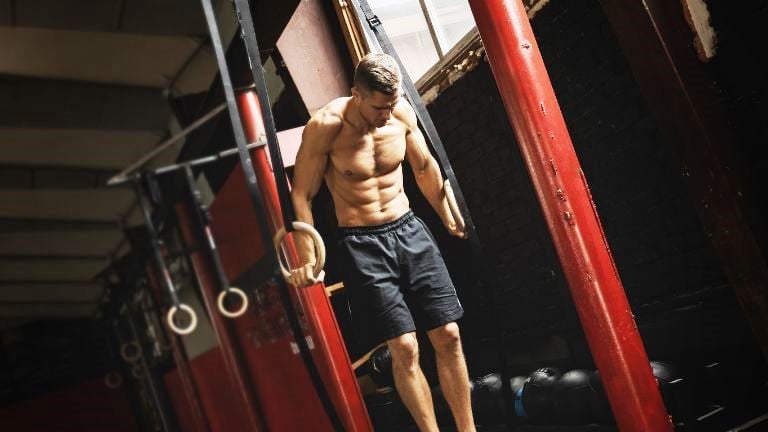
Benefits
- The ability of gymnastic rings to provide a full-body workout is highly regarded.
- The rings let you move your body naturally, which helps reduce pain in your joints.
16. Push Up Bars
Push-Up Bars, or push-up handles or stands, are fitness tools that help push-ups work better. These bars elevate the hands off the ground and allow for a deeper range of motion.
They are often made from metal, plastic, or a combination of foam or rubber grips.
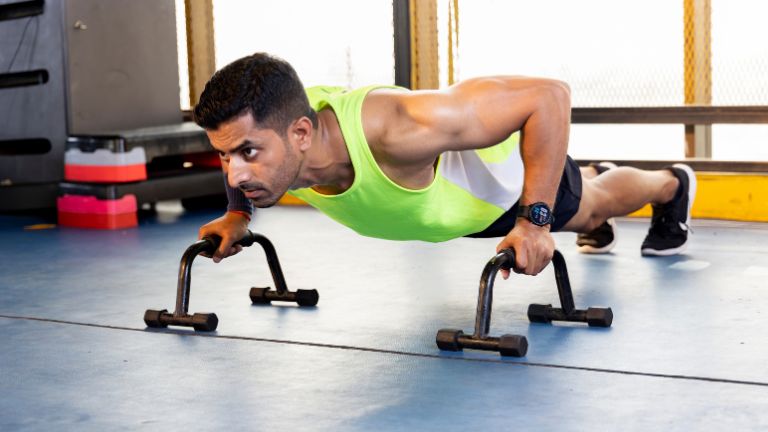
Benefits
- The neutral grip position can help alleviate wrist pain and discomfort.
- It makes push-ups more challenging.
- It is ideal for home gyms, travel workouts, or outdoor use.
17. Foam Roller
The foam roller, a cylindrical piece of dense foam, is more than just a gym accessory for sore muscles. It’s a powerful tool for self-massage, recovery, and even performance enhancement.
This practice can help release muscle tension, reduce inflammation, and improve overall flexibility and mobility.
According to a study, foam rolling has been shown to potentially benefit the recovery of dynamic measures (multijoint, sport-specific movements) during the Delayed Onset Muscle Soreness (DOMS) period.
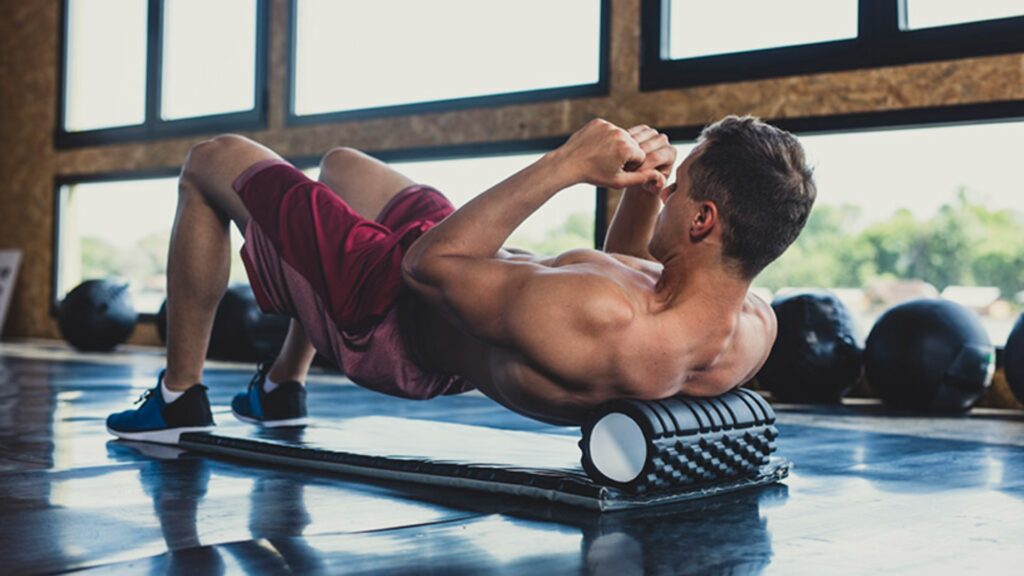
Types of Foam Rollers
- High-density foam: The classic version is ideal for deeper tissue massage and targeting trigger points.
- Soft-density foam: Gentler on sensitive muscles and perfect for beginners or those with chronic pain.
- Textured foam: Bumps and grooves provide a more intense massage and effectively target specific areas.
- Trigger point balls: Small, firm balls for pinpoint pressure on specific trigger points and tight knots.
Benefits
- Foam rolling can help alleviate chronic muscle pain by breaking up knots or muscle trigger points.
- It will help restore your full range of motion and allow your muscles to load and perform better during sports and exercise.
18. Agility Ladder
An Agility Ladder is a piece of gear commonly found in sports training and fitness. It is designed to boost quickness, coordination, agility, and balance.
They are typically made from lightweight plastic or fabric for the rungs and durable nylon or similar materials for the side rails.
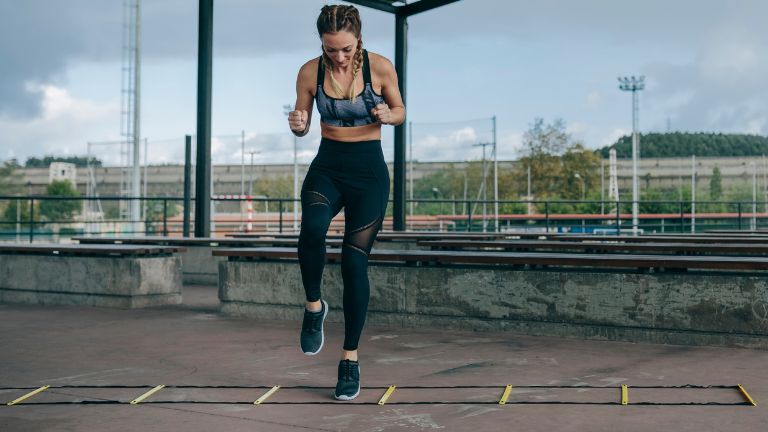
Benefits
- It’s a simple yet effective tool for athletes and those looking to enhance their physical performance.
- It benefits athletes in sports like soccer, basketball, football, and tennis.
- Provide a high-intensity cardio workout.
19. Stability Ball
A Stability Ball is also known as an exercise ball, Swiss ball, or balance ball. It is a large, inflatable ball used for strength training and improving balance.
It is a popular tool both in gyms and home workout spaces due to its versatility and effectiveness.
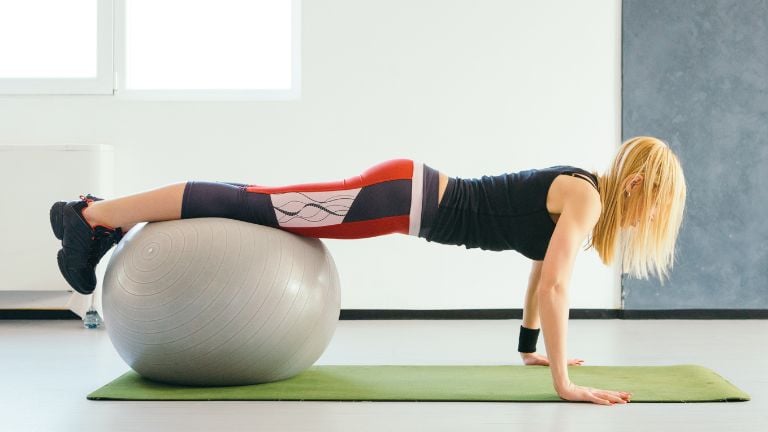
Types of Stability Balls
- Standard Stability Balls: Made of soft elastic and filled with air. It comes in various sizes to accommodate different heights.
- PVC: Affordable and widely available, good for basic exercises but less durable than other options.
- Anti-Burst Stability Balls: Designed to slowly deflate if punctured. Add safety and peace of mind.
- Weighted: Filled with small weights for an extra challenge. It is ideal for advanced users looking to boost strength and cardio.
Benefits
- It’s great for gentle rehabilitative exercises to increase flexibility and range of motion.
- People with joint pain or those recovering from injury can use it.
- You can do various exercises with them, including stretches, strength training, and aerobic workouts.
20. Bosu Ball
A Bosu Ball, short for “Both Sides Up” or “Both Sides Utilized,” consists of an inflated rubber hemisphere attached to a rigid platform.
It’s like a stability ball cut in half, and it can be used with either the flat side or the dome side facing up.
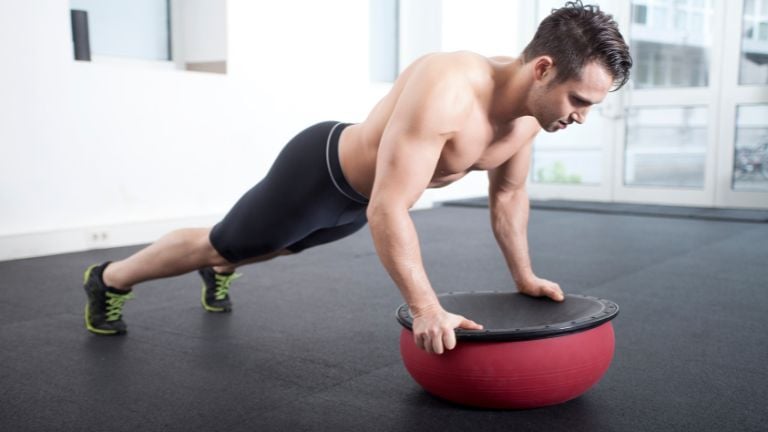
Types of Bosu Balls
- Standard Bosu Ball: Half-ball design with one flat, stable side and one domed, unstable side. It is good for general fitness, balance training, core strengthening, and aerobic exercises.
- Bosu Elite: A heavier-duty model designed for more intense use and athletic training.
- Bosu Sport: Smaller in diameter, designed for compact spaces or specific workouts.
- Bosu Pro Balance Trainer: Professional-grade model designed for commercial use with enhanced durability.
Benefits
- It’s useful for improving agility, reaction time, and motor skills and is great for sportspeople.
- You can do many exercises with Bosu, including push-ups, squats, plank variations, lunges, and many core exercises.
21. Medicine Balls
Medicine balls are versatile, portable fitness tools used for strength training, conditioning, and rehabilitation.
They come in various sizes and weights and are often made of rubber, leather, or vinyl.

Types of Medicine Balls
- Standard Medicine Balls: Durable, with a slightly bouncy surface. It is best for exercises like throws, squats, and abdominal work.
- Dual Grip Medicine Balls: quipped with handles on either side.
- Soft Medicine Balls (Wall Balls): Larger, softer, and more pliable than standard medicine balls. Good for high-velocity workouts like wall throws
- Slam Balls: Designed to be more durable and have little to no bounce. It is best for High-impact throwing exercises, particularly slams against the floor or wall.
- Toning Balls (Mini Medicine Balls): Smaller, lighter, often used in pairs.
Benefits
- They make your workout more fun and keep you interested and motivated.
- Excellent for training the core muscles through rotational movements and throws.
22. Hand Gripper
Hand gripper exercises are specifically designed to target forearm and improve grip strength.
They engage the muscles of the hands, fingers, and forearms. It enhances the strength of grip and hand dexterity.
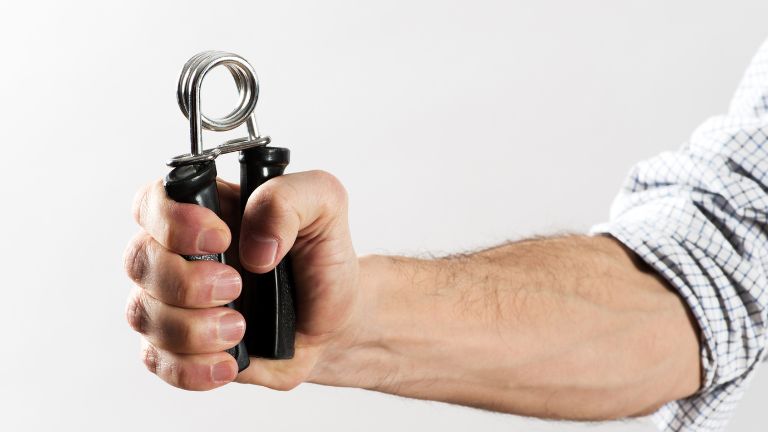
Benefits
- Hand grippers are compact and portable, making them convenient for use anywhere at home, in the office, or while traveling.
- They provide a quick and effective way to work on grip strength without requiring a full gym setup.
23. Barbell Collars
Barbell collars are an essential piece of equipment for weightlifting exercises.
They are designed to secure weight plates on the barbell, preventing them from sliding off during exercises and ensuring safety.
Barbell collars come in various forms, including spring collars, clamp collars, and screw-type pins.
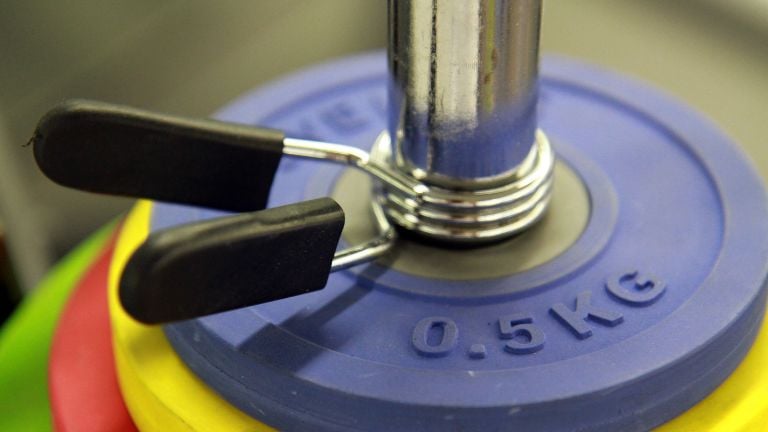
24. Yoga Mat
Yoga mats are essential equipment for practicing yoga, providing comfort, stability, and traction during various poses.
They come in various sizes, thicknesses, and materials, catering to different preferences and needs.
Yoga mats provide a cushion between your body and the hard floor, making your practice more comfortable and enjoyable.

Specialized Gym Machine Names
Most people who want to build strength should do free weights and exercises with their body weight. However, gyms now have many machines working for specific muscle groups.
The leg press to the chest fly machine are all cutting-edge tools that let you target specific muscle groups.
Learn about some of the more special equipment you can find in gyms today and how to use it safely and effectively. These gym machine tools can take your fitness to new heights using the correct technique and targeted training.
1. Seated Chest Press Machine
The chest press machine is one of the most popular gym equipment designed to work the chest muscles. The machine generally consists of a seat, a backrest, and a set of handles aligned with your chest level.
It is also known as a chest or vertical chest press machine.
Benefits
Unlike free weights, this exercise provides a guided motion, facilitating a more focused focus on the chest muscles without worrying about balance or control.
The machine is often adjustable, so you can work from different angles to engage different chest parts.
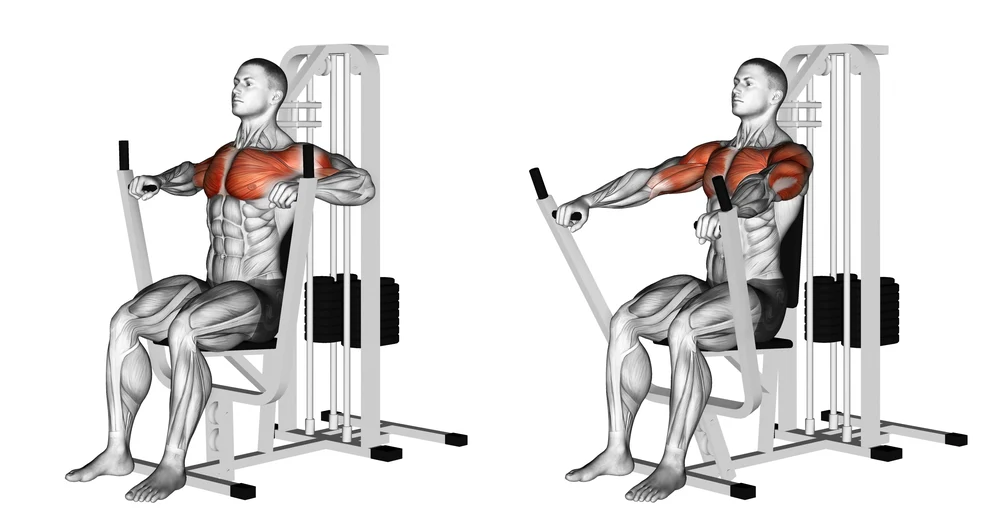
2. Pec Deck Machine
The Pec Deck Machine, also called the machine chest fly, is designed to work on the chest muscles.
It consists of a seat with a backrest and two arm pads or handles on each side.
Benefits
- Unlike the Chest Press Machine, which involves a pushing action, the Pec Deck Machine focuses on the horizontal adduction of the arm, meaning you’re bringing your arms close together in front of you.
- The angle at which you perform the machine chest fly can impact the targeted muscles, such as the upper, middle, and lower chest.
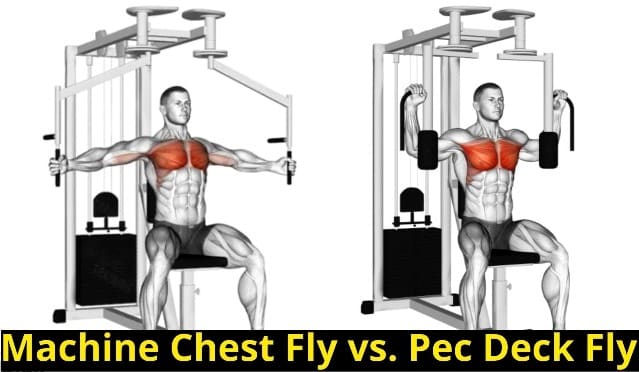
3. Cable Crossover Machine
The Cable Crossover Machine is a versatile piece of gym equipment with two adjustable cable pulleys on either side. Unlike other chest workout machines with fixed motion paths, the Cable Crossover allows for a wide range of movements.
It can particularly effectively target the chest muscles for cable chest fly or crossover exercises.
Its unique mechanics and range of motion can provide significant advantages in strengthening and sculpting your entire chest area.
Benefits
You can move the cables differently to target different parts of your chest. Such as:
- Middle Crossover: Specially target the inner chest
- Low Cable Crossover: Specially target the Upper Chest
- High Cable Crossover: Specially target the Lower Chest
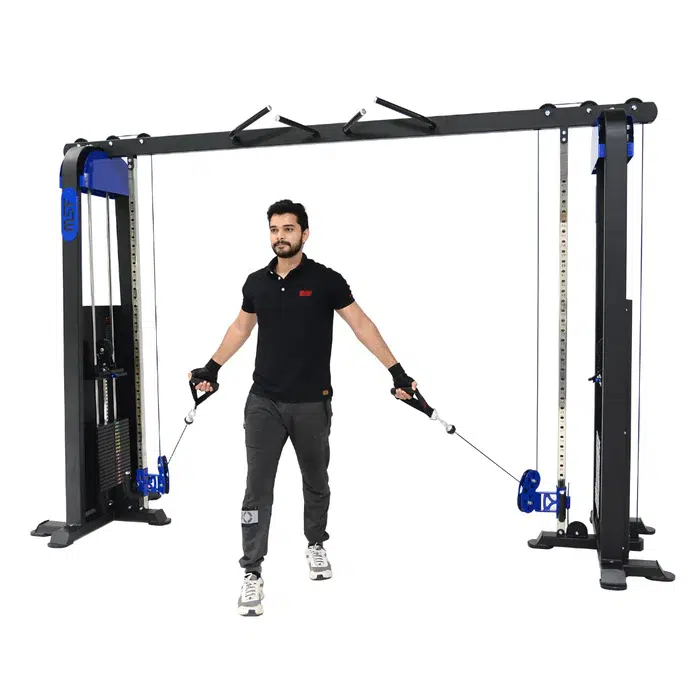
4. Chest Dip Machine
The chest dip machine is a machine-based exercise mimicking a triceps dip, a bodyweight exercise performed on parallel bars, or a pull-up and dip station.
It consists of two parallel bars or handles attached to a weight stack.
Benefits
- The Assisted chest dip machine is a great way to train lower chest muscles.
- It can be beneficial for those who find body-weight dips challenging.
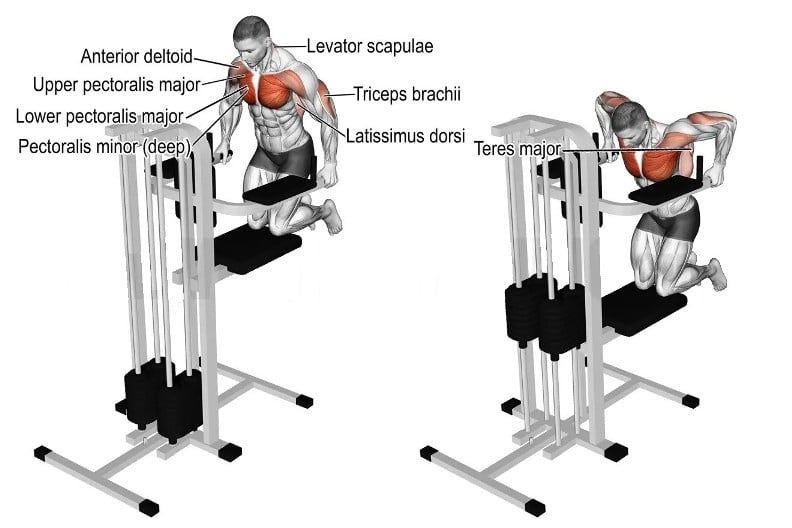
5. ISO Incline Press
The iso-lateral incline chest press machine is ideal for both of these goals. The inclined press targets the upper pectorals to build size and fullness.
The separate arm handles allow you to isolate each side and provide additional focus to your weaker pec to promote symmetry.
Benefits
For optimal chest development, focus on these two key principles in your training:
- Prioritize building the upper chest area to create impressive upper pec mass and shape.
- Train each side of the chest independently to correct muscle imbalances.
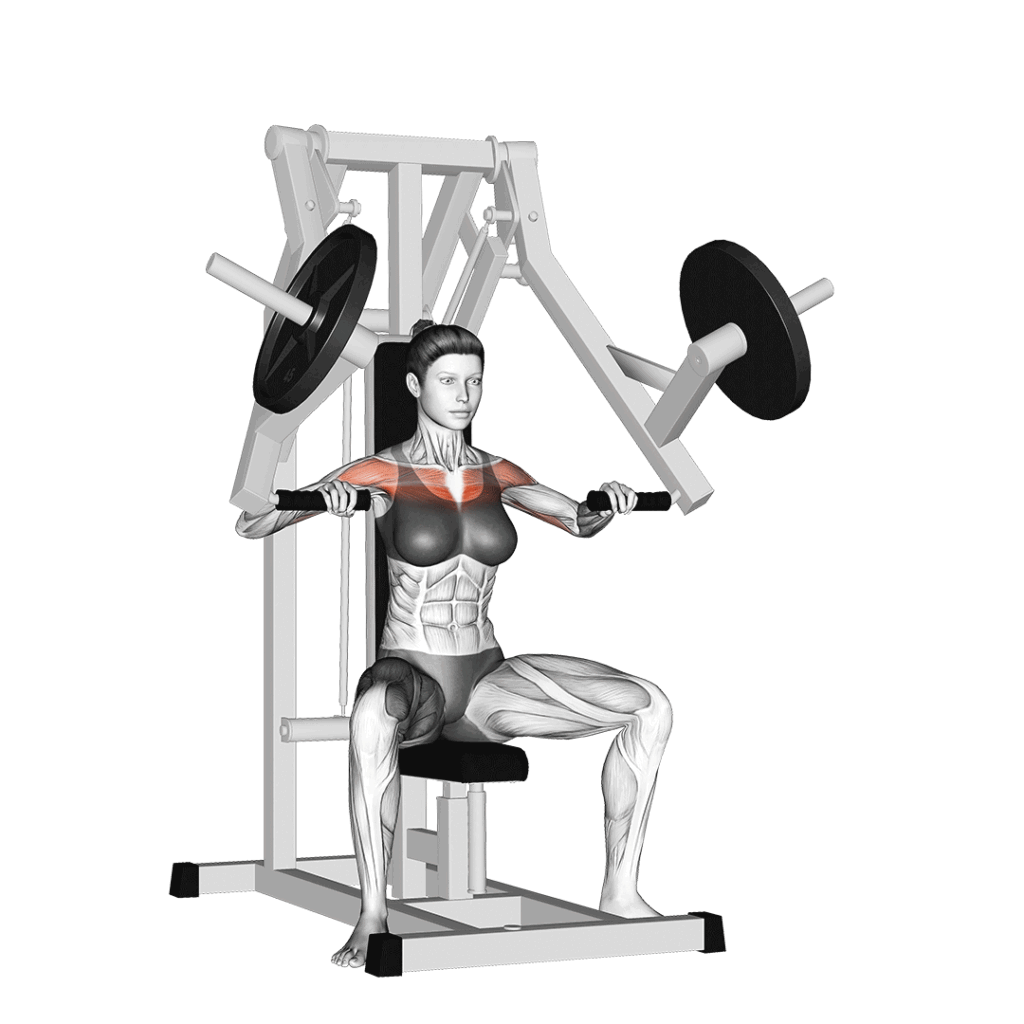
6. Lat Pulldown Machine
The Lat Pull-Down Machine is one of the most popular and versatile gym machines specifically designed to target the muscles in your back, primarily the latissimus dorsi (or “lats”).
It is a versatile machine used for various exercises to build a more robust and broader back.
Benefits
The lat pulldown can be performed with different variations.
With simple adjustments to your grip, posture, or the type of bar you use, you can turn this classic exercise into a multi-faceted tool for back development.
- Wide-grip lat pulldown
- Close-grip lat pulldown
- Reverse-grip (supination) lat pulldown
- Neutral-grip lat pulldown
- Straight-arm lat pulldown
- Single-arm lat pulldown… Many More
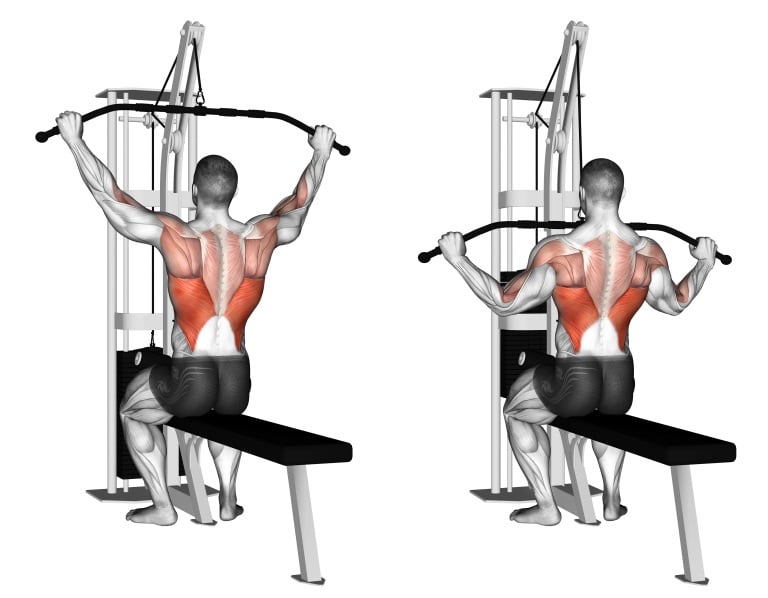
7. Seated Row Machine
The seated cable row is a compound exercise that utilizes a weighted horizontal cable row machine to work the upper body muscles.
It is an excellent all-around compound exercise for developing mainly the middle back while offering useful arm work.
Benefits
Rowing movements target the back muscles differently than vertical pulling motions like lat pulldowns. It is an excellent exercise for beginners and can be part of an upper-body strength workout.
This exercise can be performed in various ways to target back muscles from different angles.
- V-bar attachment
- Wide D Handle Row Bar
- Straight bar
- Rope
- Zigzag Handle
- D Handle
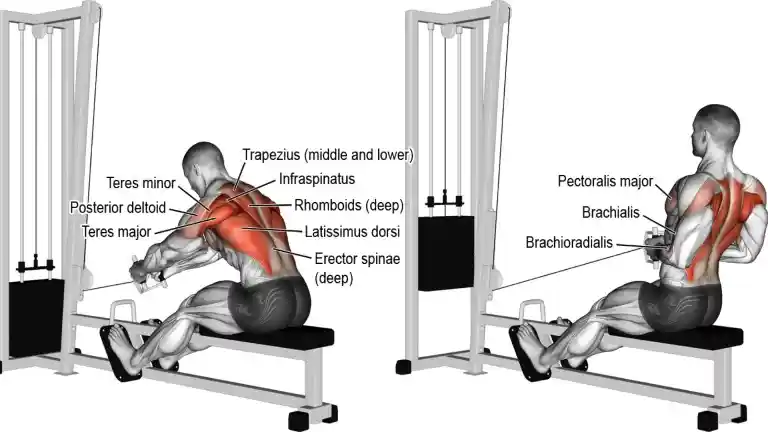
8. Chest Supported Row
The Chest Supported Machine Row is a specialized gym equipment designed to isolate your back muscles while supporting your chest and torso.
This machine is an excellent option for those with lower back issues or who want to focus exclusively on their upper back muscles since it minimizes the strain on your lower back.
Benefits
The equipment usually consists of a padded chest support, a seat, and handlebars or grips connected to a weight stack or plates. You will typically be able to use an underhand grip, overhand grip, neutral grip, close grip, and wide grip.
- The primary muscles worked are the latissimus dorsi, Traps rhomboids, and posterior deltoids.
- The Biceps and forearm assist in the pulling motion.
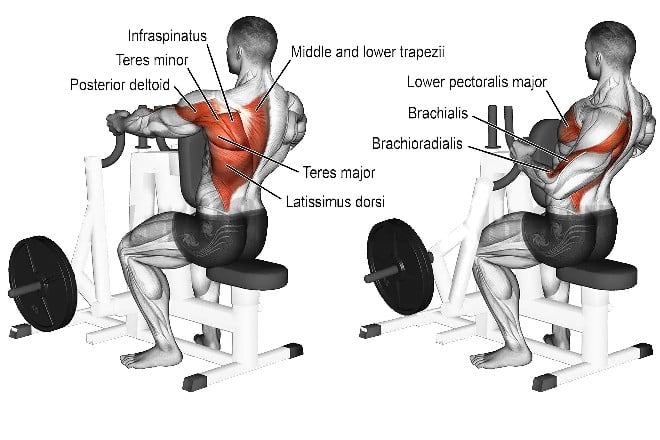
9. Landmine Row Attachment
A Landmine Row Attachment uses a barbell and a landmine unit (a ground-based rotational training device).
It transforms your barbell into a multi-directional training tool. It unlocks a range of exercises that target your muscles from different angles and intensities.
It’s designed to help you do more exercises with a landmine setup, especially rowing movements that target the back muscles.
Benefits
The angled position of the barbell gives you a different strength curve than traditional rows, which adds variety to your back workout and targets your muscles in a new way.
- The primary muscles worked by the landmine row are the latissimus dorsi, trapezius, rhomboids, and erector spinae.
- The exercise also targets secondary muscles such as the deltoids, biceps, forearm flexors, and rotator cuff.
- Additionally, the landmine row engages muscles of the core, glutes, abdominal, oblique.
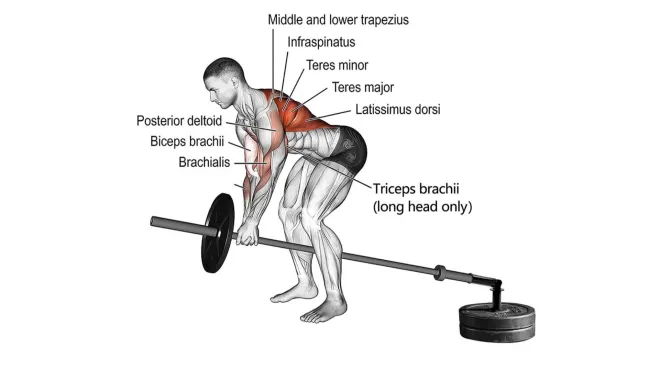
10. Back Extension Machine
The Back Extension Machine is an essential piece of gym equipment specifically designed to target the muscles in your lower back.
This machine is often found in both commercial and home gyms. It aims to strengthen your back and improve your posture.
Benefits
The machine offers a safer alternative to free weights for beginners and those recovering from an injury.
It’s a simple exercise to learn, so you can start using it right away.
- The primary muscles worked by the back extension are the erector spinae muscles.
- The exercise also targets secondary muscles such as the glutes and hamstrings.
- Additionally, the back extension engages the core, abdominal muscles, and oblique.
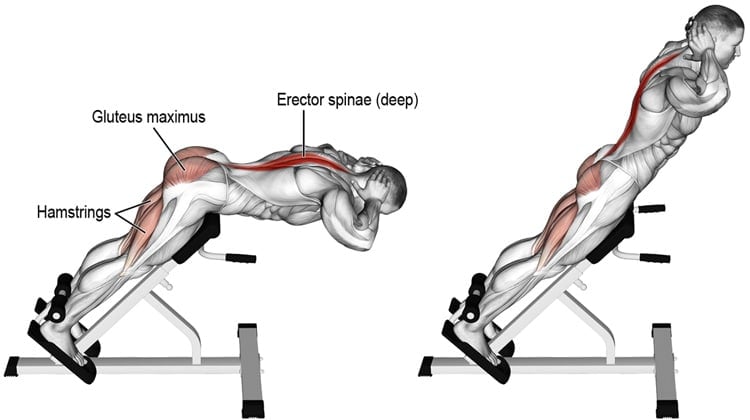
11. Shoulder Press Machine
The Shoulder Press Machine, sometimes called the “Military Press Machine,” is a staple in gyms and fitness centers worldwide.
This machine is specifically designed to target the shoulder muscles, as it provides a controlled environment for overhead pressing movements.
The shoulder machine press is excellent for building the front and side deltoid muscles.
Benefits
- Provide better stability and safety. They also offer a choice of handgrips.
- A neutral grip (palms facing together) focuses more on the anterior deltoid better than a pronated grip (palms forward).
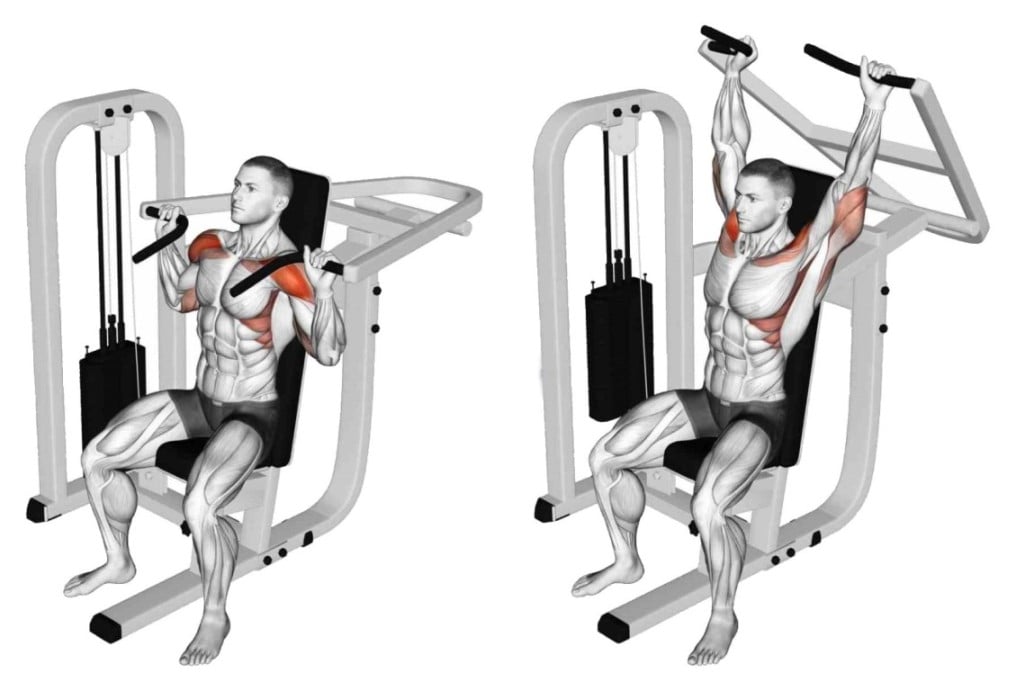
12. Lateral Raise Machine
The Lateral Raise Machine is a special piece of gym equipment that helps isolate the deltoid muscles, especially the side delt.
The machine consists of a seat with a backrest, a set of handles attached to weight stacks, and a lever used to adjust the weight.
The range of motion is controlled, so you can target these muscles without working other muscle groups.
Benefits
- It allows for a safer and more stable workout experience.
- The exercise helps build shoulder strength and mass, improve mobility and flexibility, and upper back strength.
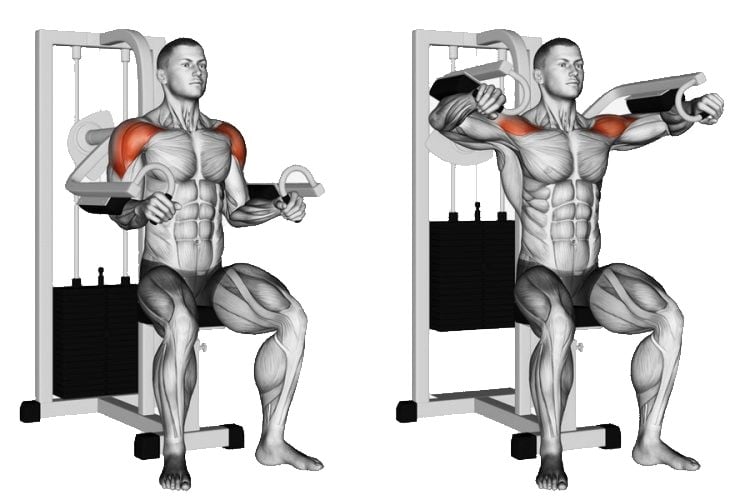
13. Shrug Machine
The Shrug Machine, also called the Trap Machine, is a special piece of gym equipment that makes doing shrugs easier and effective.
The lever or handles usually align with your shoulders, providing a comfortable grip and a controlled range of motion.
Benefits
- Unlike dumbbells or barbells, the Shrug Machine targets the upper trapezius muscles and minimizes the involvement of other muscle groups.
- Its ergonomic design lets you focus on muscle engagement, making it a good choice for targeting the trapezius muscles.
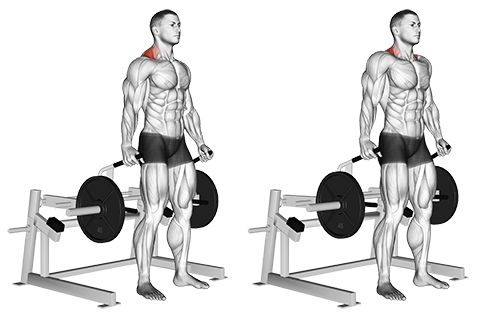
14. Preacher Curl Machine
The preacher curl machine is a great way to achieve a peak contraction of the biceps muscles.
The design of the machine forces your arms to remain in a fixed position, which helps to isolate and target the biceps.
Benefits
- It allows you to use a heavier weight than you could with free weights.
- With a preacher curl, you get many benefits that don’t come with regular bicep curls.
- Do preacher curl with a slightly wider grip to impart more load on short-head biceps.
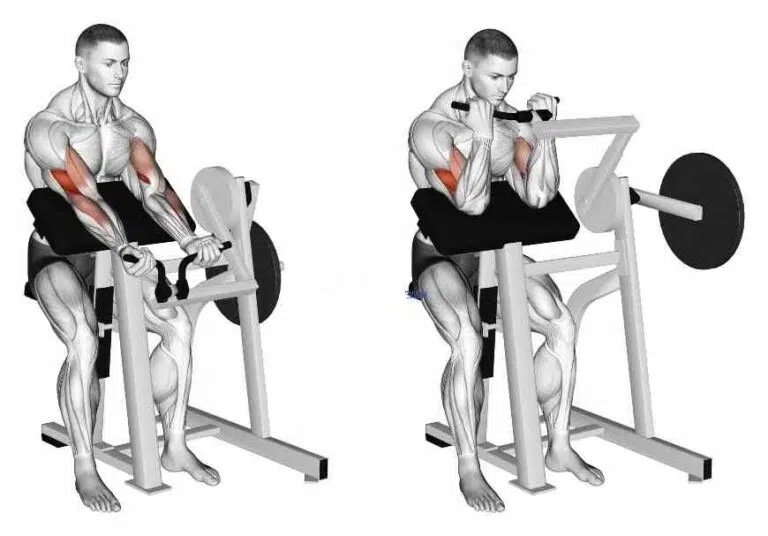
15. Machine Tricep Dip
The tricep machine dip is a type of strength training equipment that is designed to work the muscles in the triceps.
It is a variation of the traditional tricep dip that uses a machine instead of body weight.
Benefits
- It provide a more controlled and isolated environment than a parallel bar dip.
- It minimizes the use of the chest, shoulders, and back.
- It is a great exercise for beginners who want bigger, stronger arms.
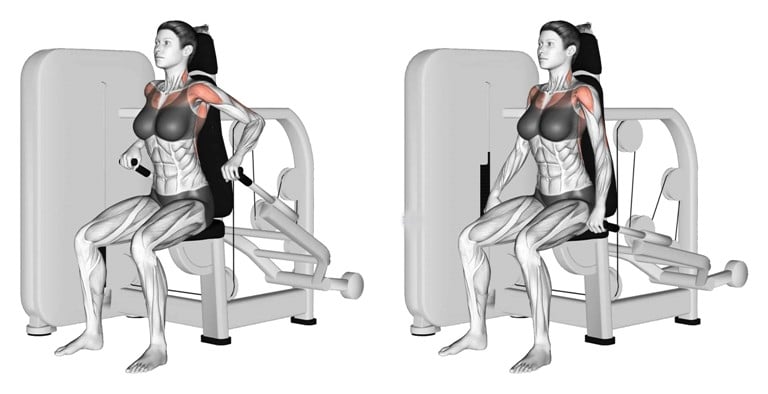
16. Forearm Wrist Curl Machine
The forearm wrist curl machine is designed to isolate and train the muscles of your forearms, particularly the flexors and extensors
These machines are popular in many gyms and are particularly favored for their targeted approach to forearm training.
Benefits
Most wrist curl machines allow you to perform both wrist curls (bending your wrist upwards) and wrist extensions (bending your wrist downwards).
This lets you train both major muscle groups in your forearms for a well-rounded workout.
Rolling motion strengthens the grip and improves joint stability and range of motion.
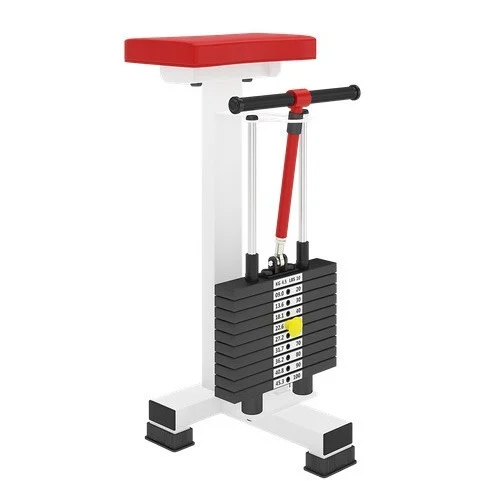
17. Reverse Hyperextension
Reverse hyperextension is an exercise that targets the lower back muscles, particularly the erector spinae. It’s a multipurpose workout that can also be used to strengthen the hamstrings, glutes, and hip flexors.
Benefits
- It is a low-impact exercise that is good for people with a weak back.
- If you’re new, you may start with just the weight of your legs or add minimal weight and increase as you become more comfortable.
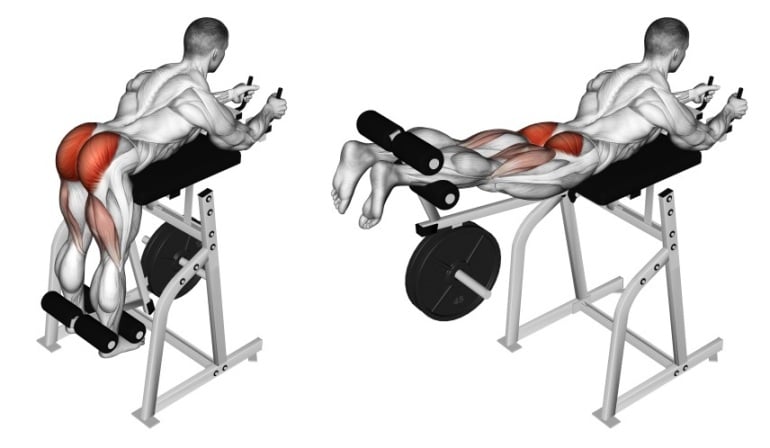
18. Glute Ham Raise
The glute ham raise is a bodyweight exercises that targets the lower back, glutes, hamstrings, and calves.
This exercise is typically performed on a Glute Ham Developer machine and is a staple in strength and conditioning programs.
Benefits
- The glute ham raise effectively targets the hamstrings during the eccentric (lowering) portion.
- It also enhances lower back and spinal health due to the isometric contraction required to keep the spine neutral during the exercise.
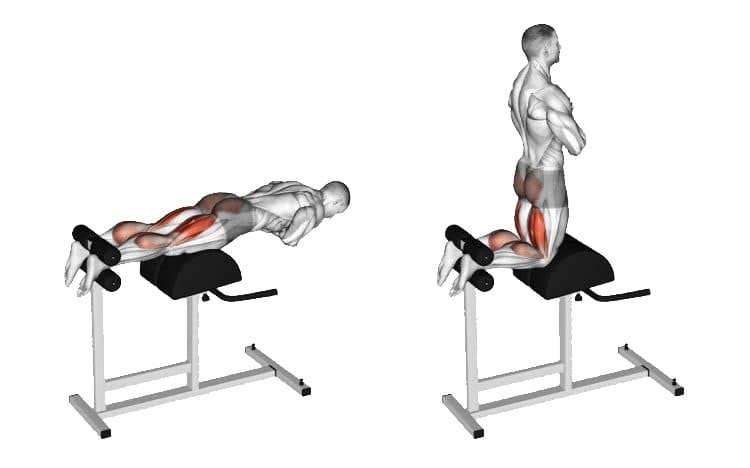
19. Seated Back Extension
Seated Back Extension is a variation of the classic back extension exercise but performed in a seated position.
This exercise uses a machine to help strengthen the muscles in the lower back, also called the lumbar region.
There are several setup variations for the machine, but these differences in the backrest, footrest, leg clamps, or the presence of handles for stabilization don’t affect the exercise much.
Benefits
- The seated position allows you to isolate your lower back muscles more effectively than some other types of back exercises.
- It provides a safer and more controlled way to work your lower back without putting undue stress on your spine.
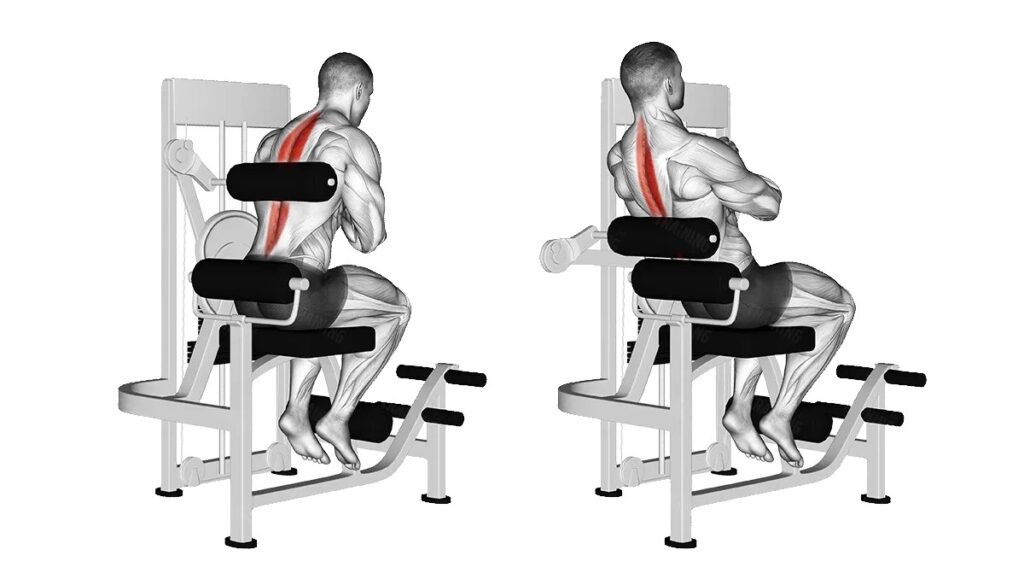
20. Captain’s Chair
The Captain’s Chair, also referred to as a vertical knee raise station, is commonly found in gyms. It has a tall frame with armrests and back support, so the user can hang freely.
Benefits
Although the chair uses the same muscles as a hanging leg raise, it supports your back, which makes it more comfortable for most people.
After performing a small study, the American Council on Exercise named the standard Captain’s Chair crunch one of the most effective ab exercises for stimulating the abs and obliques.
Some of the exercises that can be performed on the Captain’s Chair include:
- Straight leg raises – Raise legs up together to 90 degrees
- Bicycle crunches – Bring alternate knees to chest
- Hanging knee raises – Bring bent knees to chest
- Oblique knee raises – Bring right knee to left elbow, twist obliques
- Flutter kicks – Rapid, small kicks replicating swimming
- L-sit holds – Holding the Leg raise at 90 degrees.
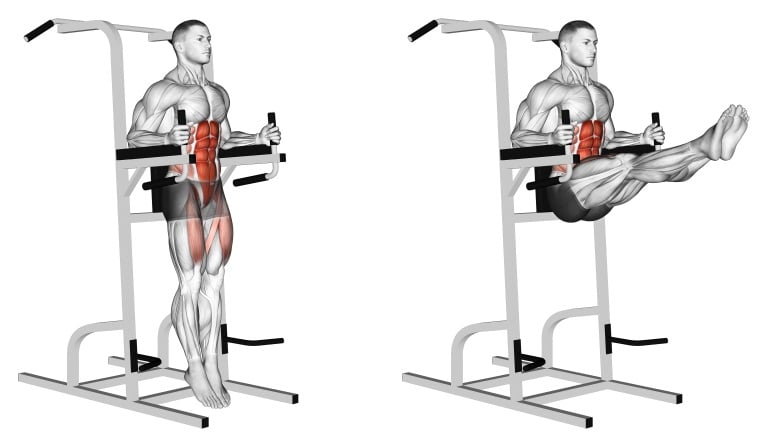
21. Oblique Machine Twist
The Oblique Twist Machine, also known as the Rotary Torso Machine, is specifically designed to work on the oblique muscles on the sides of the abdomen.
It is a versatile piece of equipment to help you achieve a stronger and more toned core.
Benefits
These machines typically consist of a seat that the user sits on and a cushioned handle in front that the user holds on to.
The machine lets you rotate your trunk against resistance. This effectively targets your core muscles, including the obliques, quadratus lumborum, rectus abdominis, and transverse abdominis.
Ab exercises you can do with the oblique twist machine:
- Seated machine oblique twist
- Standing machine oblique twist
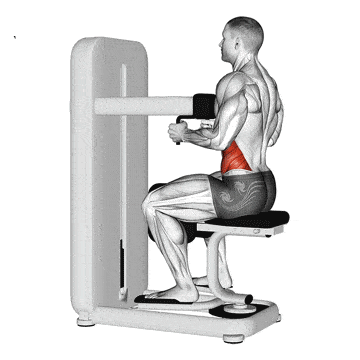
22. Abs Crunch Machine
The crunch machine is an excellent way to strengthen your abdominal muscles by using a crunch machine.
Benefits
- The machine typically consists of a seat, backrest, and handles or bars that the user pulls to perform the crunch motion.
- It’s a good way to add resistance to your abdominal exercises for better abs and core development.
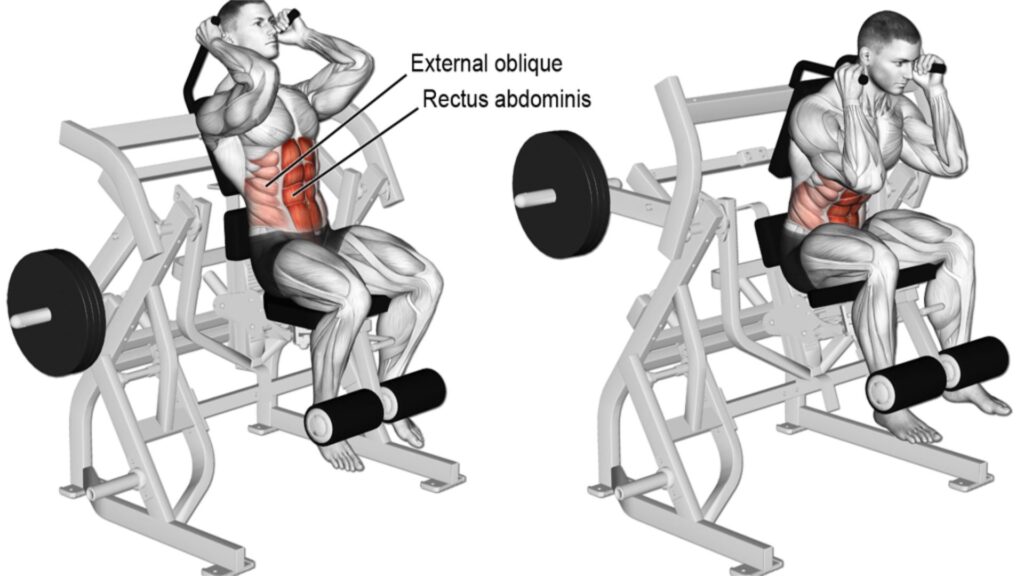
23. Abs Wheel Roller
If you want to get more creative with your abs machine workout, why not try an Abs wheel rollout?
The abs wheel roller is a simple but effective exercise tool that can help you strengthen your abdominal muscles. It is one of the more advanced exercises.
Benefits
Other benefits of using an abs roller include improved core strength, hip flexor mobility, and shoulder stability.
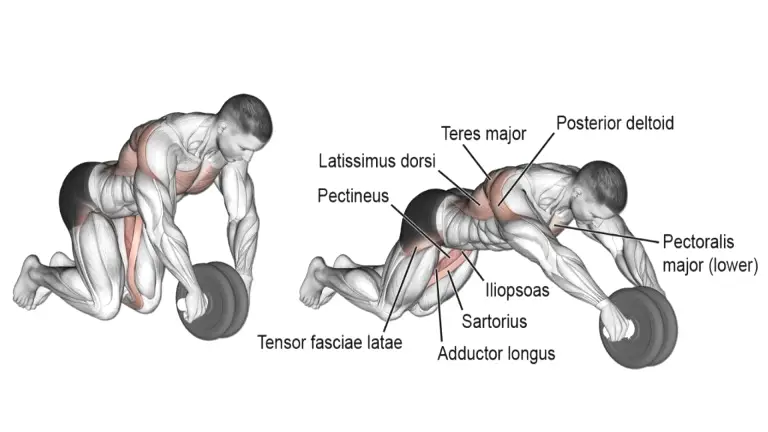
24. Leg Press Machine
The leg press machine is a popular piece of gym equipment that targets the lower body muscles, particularly the quads, hamstrings, and glutes.
The machine has a compact design with a backrest that can be adjusted and two safety catches for added stability.
It can also hold up to 1,000 pounds and has a high-tensile strength carriage system for smooth weight training.
Benefits
- If you’re worried about your lower back hurting, leg presses are the best exercises for building and toning your thighs.
- In comparison with the barbell squat, the seated leg press exercises reduce the axial load on your spine and reduce the risk of backache.
- It is a versatile machine that can be used for leg presses, hack squats, forward thrusts, and calf raises.
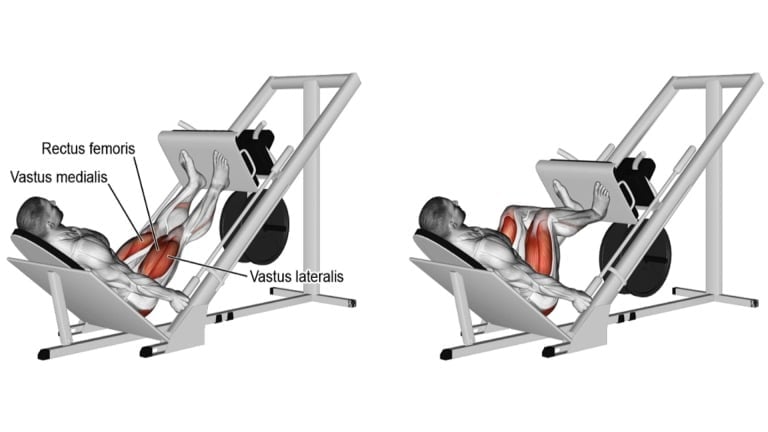
25. Leg Extension Machine
A leg extension machine is a piece of gym equipment that targets the quadriceps muscles in the legs.
come in various forms, including plate-loaded and adjustable machines. Some machines let you do leg curls that work the hamstring muscles.
Benefits
- It is an isolation exercise that is performed on a leg extension machine to build and shape your quad muscles.
- The leg extension exercises should only be used to warm up your quads, pre-exhaust them before squats, or flush them at the end of a leg workout.
- They are also used in physical therapy to help patients recover from leg injuries.
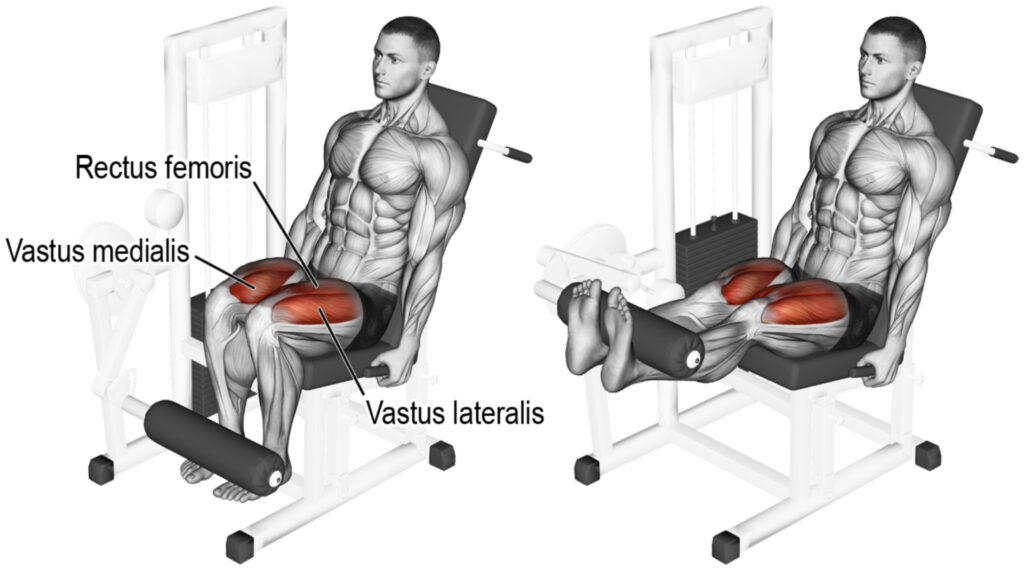
26. Leg Curl Machine
Leg curl machines are designed to target the hamstring muscles.
The machine is available in various forms, including plate-loaded and adjustable machines.
Benefits
- It is the best way to build muscle mass in the hamstrings (back of thigh muscles). It also works the calf and glute muscles.
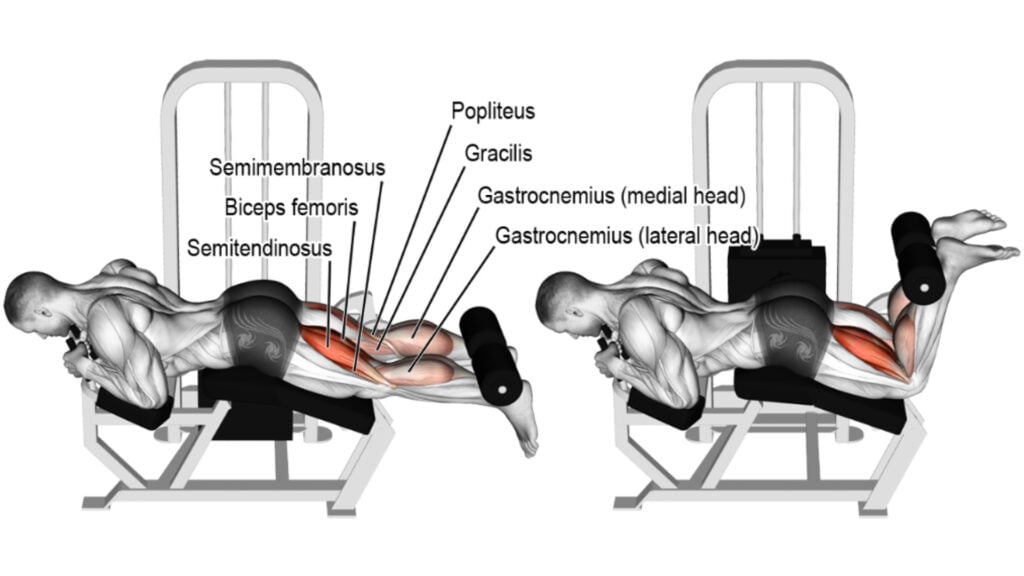
27. Hack Squat
The machine provides a unique squatting movement that isolates the lower body muscles differently than traditional squats.
It is a variation of the squat and an exercise used to build the muscles of the legs.
Benefits
- Hack squat will target the glutes & hip flexors, and quadriceps and also involves the calves and hamstrings.
- It helps you keep your core stable, so your muscles do not have to work as hard as they would with the barbell squat.
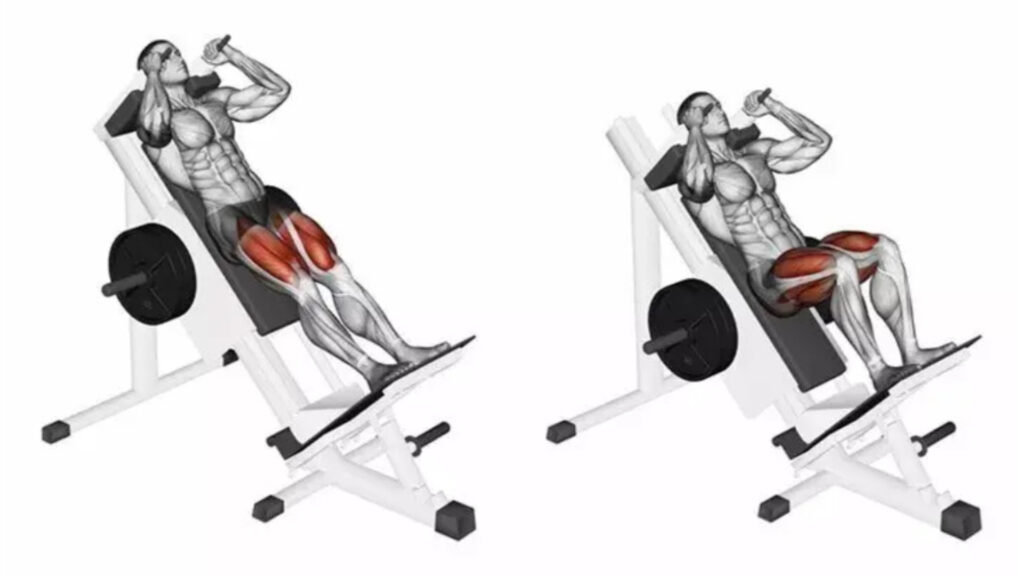
28. Standing Leg Curl Machine
The standing leg curl machine is a fantastic tool for sculpting strong and defined hamstrings.
In contrast to the lying leg curl, the standing leg curl is performed with one leg at a time, which helps muscle isolation and focus.
Benefits
- Strengthens the hamstrings, buttocks, and calves.
- The machine isolates the hamstrings, allowing you to directly target and fatigue the hamstring.
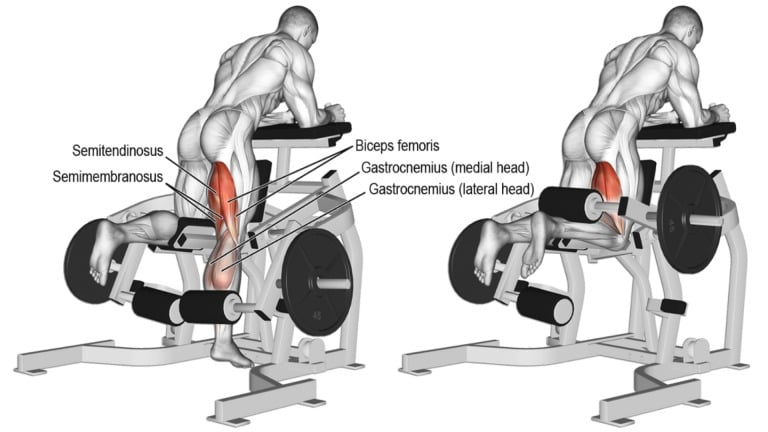
29. Standing Machine Calf Raise
The standing machine calf raise machine is an excellent method of isolating the calves.
It consists of a raised platform to stand on and a padded lever or shoulder pads.
Users place their shoulders under the pads and stand with the balls of their feet on the edge of the platform.
Benefits
- It works the two muscles that run down the back of your lower leg: the gastrocnemius and soleus.
- The machine helps maintain the proper form by guiding the movement.
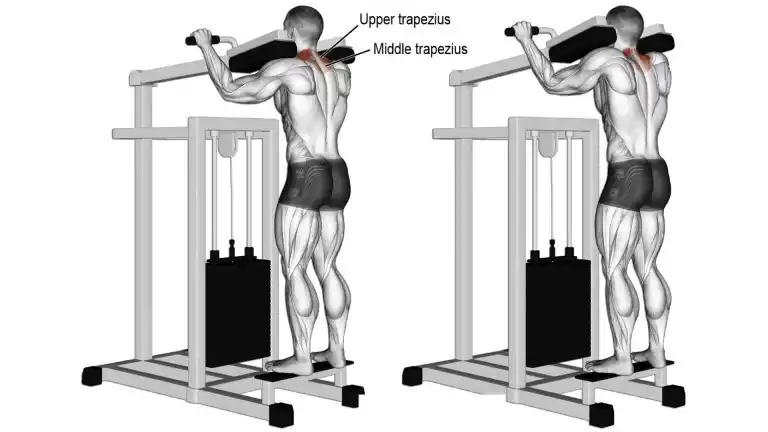
30. Seated Machine Calf Raise
The seated calf raise is one of the best strength-gaining exercises that targets your calf muscles and accelerates their growth.
In the seated calf raise, your soleus is the target muscle and your gastrocnemius is the synergy muscle.
Since the soleus comprises slow-twitch muscle fibers, performing the seated calf raise builds the endurance required for running, cycling, and walking.
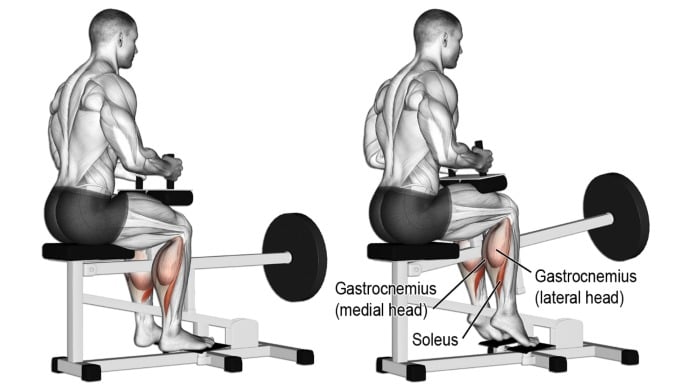
Cardio Equipment Names
Strength training is important, but cardio workouts should also be integral to a well-rounded fitness regimen.
Cardio machines, such as treadmills, ellipticals, exercise bikes, and stair climbers, help improve heart health, endurance, circulation, and more.
They help you burn many calories, which is important for losing weight and fat. You can train your body and mind while keeping energy levels high with a heart-healthy cardio workout.
1. Treadmill
A Treadmill is a popular exercise machine used for indoor running or walking. It features a moving platform with a wide conveyor belt driven by an electric motor or a flywheel.
Treadmills are commonly found in gyms and are also popular for home use.
It offers a range of speeds and incline options to vary the intensity of the workout.

Benefits
- Excellent for cardiovascular workouts.
- Effective for burning calories and aiding in weight loss.
- It is equipped to track and record workout progress over time.
2. Elliptical Trainer
An Elliptical Trainer, or a cross-trainer, is a stationary exercise machine. It often includes stationary and moving handlebars to engage the upper body.
Many ellipticals offer pre-set workout programs for varied exercise routines.
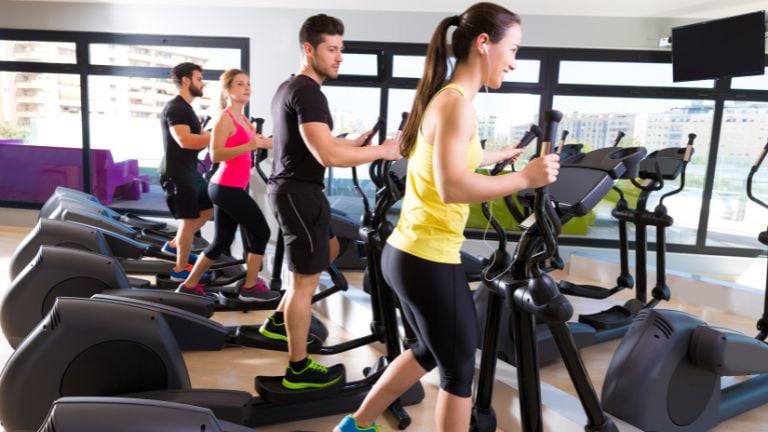
Benefits
- Engages both upper and lower body for a full-body workout.
- It offers forward and backward stride movements to target various muscles.
3. Stationary Bike
A Stationary Bike, also called an exercise bike, is a piece of fitness equipment that mimics the operation of a bicycle while remaining stationary.
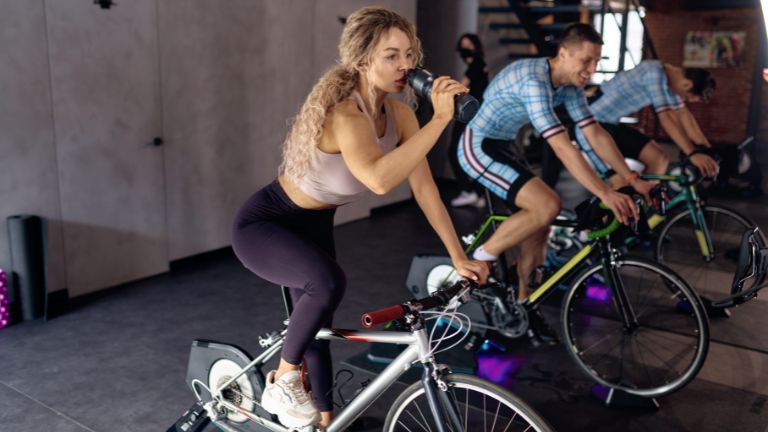
Benefits
- It strengthens your lower body, including your thighs, hips, and glutes.
- Suitable for beginners, seniors, and advanced athletes.
4. Rowing Machine
The Rowing Machine, often just referred to as a “rower,” is a gym equipment piece designed to simulate the action of rowing a boat.
It is an excellent tool for cardiovascular conditioning while also providing substantial muscular engagement across various body parts.
It is consisting of a sliding seat, footrests, a handle attached to a chain or rope, and a flywheel for resistance.
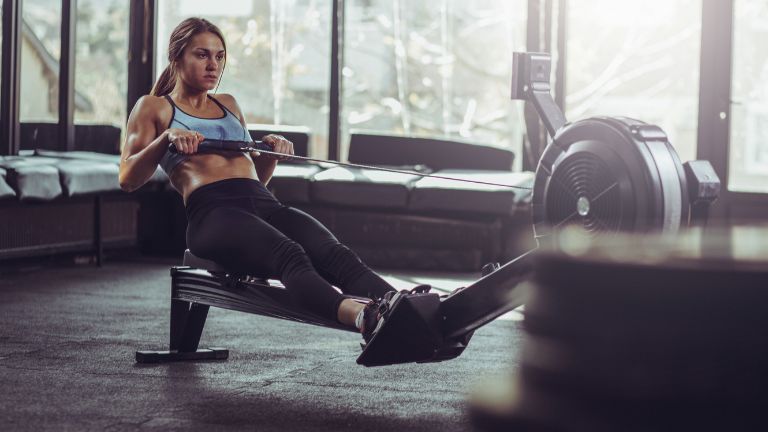
Benefits
Rowing machines are an all-in-one solution for burning calories, improving cardiovascular health, or gaining strength.
The rowing machine engages multiple muscle groups, making it a comprehensive workout option:
- Leg Muscles: Quadriceps, hamstrings, and calves are engaged during the leg push-off phase.
- Back Muscles: The latissimus dorsi, rhomboids, and upper traps are worked as you pull the handle toward you.
- Core Muscles: Your abs, obliques, and lower back.
- Arm Muscles: Both the biceps and triceps are worked during the pulling and recovery phases.
- Shoulder Muscles: The rear deltoids are engaged when pulling the handle, while the front deltoids are involved during the recovery.
5. Stair Climber
A Stair Climber, also known as a stair stepper, is a cardio machine that simulates the action of climbing stairs.
Stair climbers are available in various forms, including step mills, pedal steppers, and mini steppers.
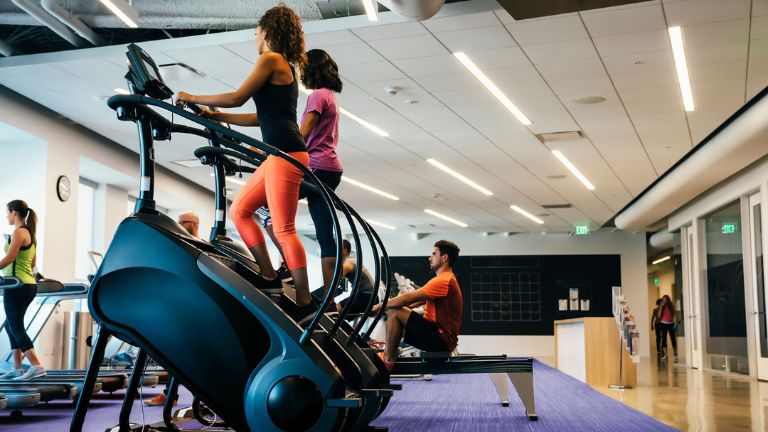
Benefits
- There is less strain on the joints compared to running or jogging.
- A good option for smaller workout spaces.
Conclusion
There you have it, our complete guide to gym equipment names and must-know machines.
We hope this reference list helps you easily navigate any gym floor and add new tools to your workouts.
It can take time to familiarize yourself with certain equipment, but you should know that no one masters these machines overnight.
The beauty of fitness is that it is always evolving, as is gym technology. Keep practicing regularly, and each piece of equipment will become second nature.
Please let us know in the comments which of these fantastic gym machines you’re most excited to try out.

Manish is a NASM-certified fitness and nutrition coach with over 10 years of experience in weight lifting and fat loss fitness coaching. He specializes in gym-based training and has a lot of knowledge about exercise, lifting technique, biomechanics, and more.
Through “Fit Life Regime,” he generously shares the insights he’s gained over a decade in the field. His goal is to equip others with the knowledge to start their own fitness journey.

Excellent website to get knowledge of gym equipments.